Innovative Logistics and Supply Chain Methods for Liquefied Natural Gas Project Success in Mozambique
VerifiedAdded on 2023/01/13
|21
|8035
|72
AI Summary
This research focuses on the innovative logistics and supply chain methods for ensuring the success of the liquefied natural gas project in Mozambique. It explores different methods, their importance, opportunities, and challenges in the LNG industry.
Contribute Materials
Your contribution can guide someone’s learning journey. Share your
documents today.
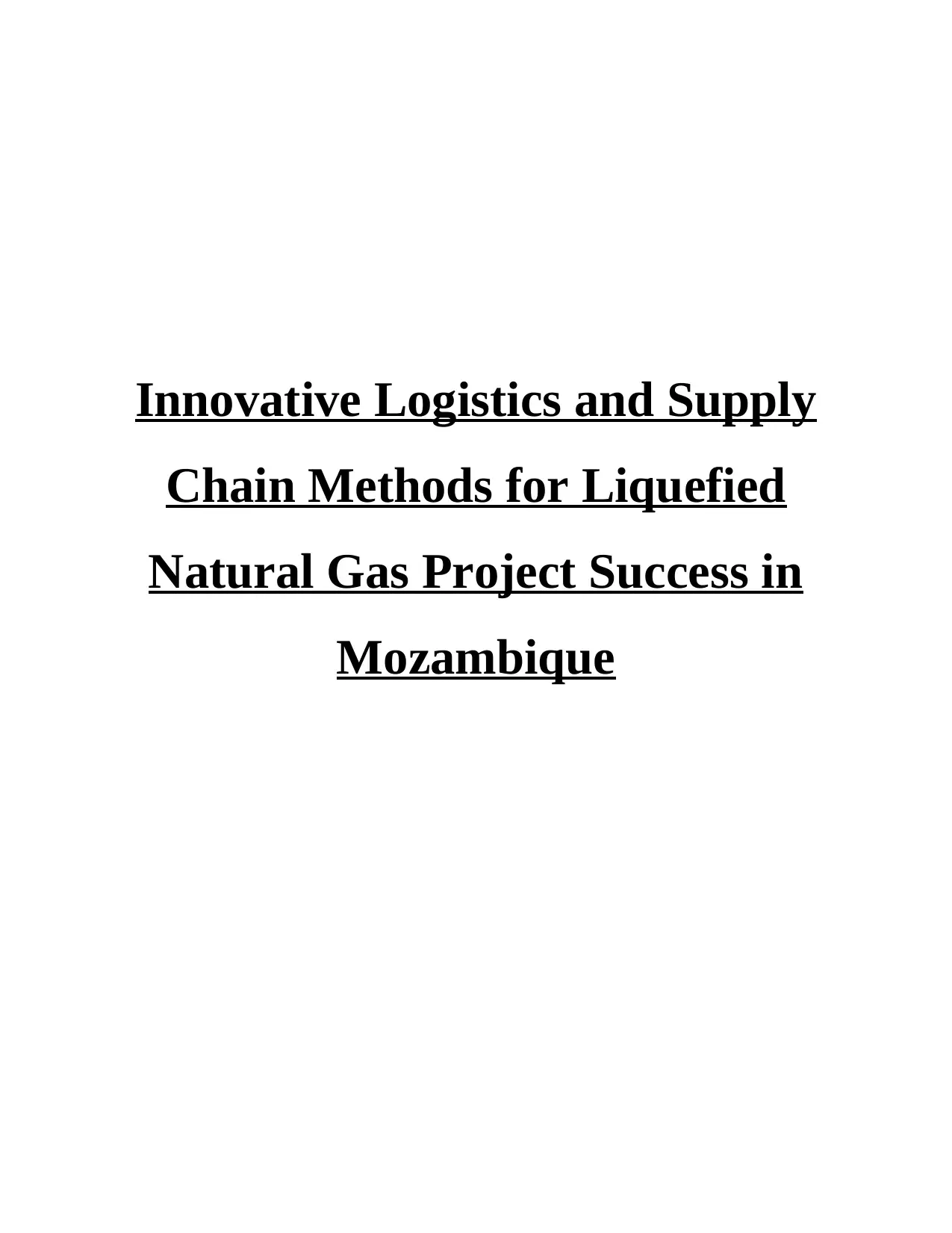
Innovative Logistics and Supply
Chain Methods for Liquefied
Natural Gas Project Success in
Mozambique
Chain Methods for Liquefied
Natural Gas Project Success in
Mozambique
Secure Best Marks with AI Grader
Need help grading? Try our AI Grader for instant feedback on your assignments.

ABSTRACT
Logistics is the critical component in supply chain administration and line up the
multifaceted transportation patterns, purchasing, shipping, warehousing, import and export
operations, customer service as well as production planning. Mozambique liquefied natural gas is
an emerging leader in global LNG industry that work to develop liquefied natural gas facility in
province of Cabo Delgado. The innovative logistics and supply chain methods highly contributes
in ensuring success of liquefied natural gas project in Mozambique. Apart from this, various
opportunities are represented by Mozambique liquefied natural gas project including cleaner
source of energy that do not provide any harm to environment, enables to produce and market
large quantity of fuel etc. all this will highly contribute in success of project.
Logistics is the critical component in supply chain administration and line up the
multifaceted transportation patterns, purchasing, shipping, warehousing, import and export
operations, customer service as well as production planning. Mozambique liquefied natural gas is
an emerging leader in global LNG industry that work to develop liquefied natural gas facility in
province of Cabo Delgado. The innovative logistics and supply chain methods highly contributes
in ensuring success of liquefied natural gas project in Mozambique. Apart from this, various
opportunities are represented by Mozambique liquefied natural gas project including cleaner
source of energy that do not provide any harm to environment, enables to produce and market
large quantity of fuel etc. all this will highly contribute in success of project.
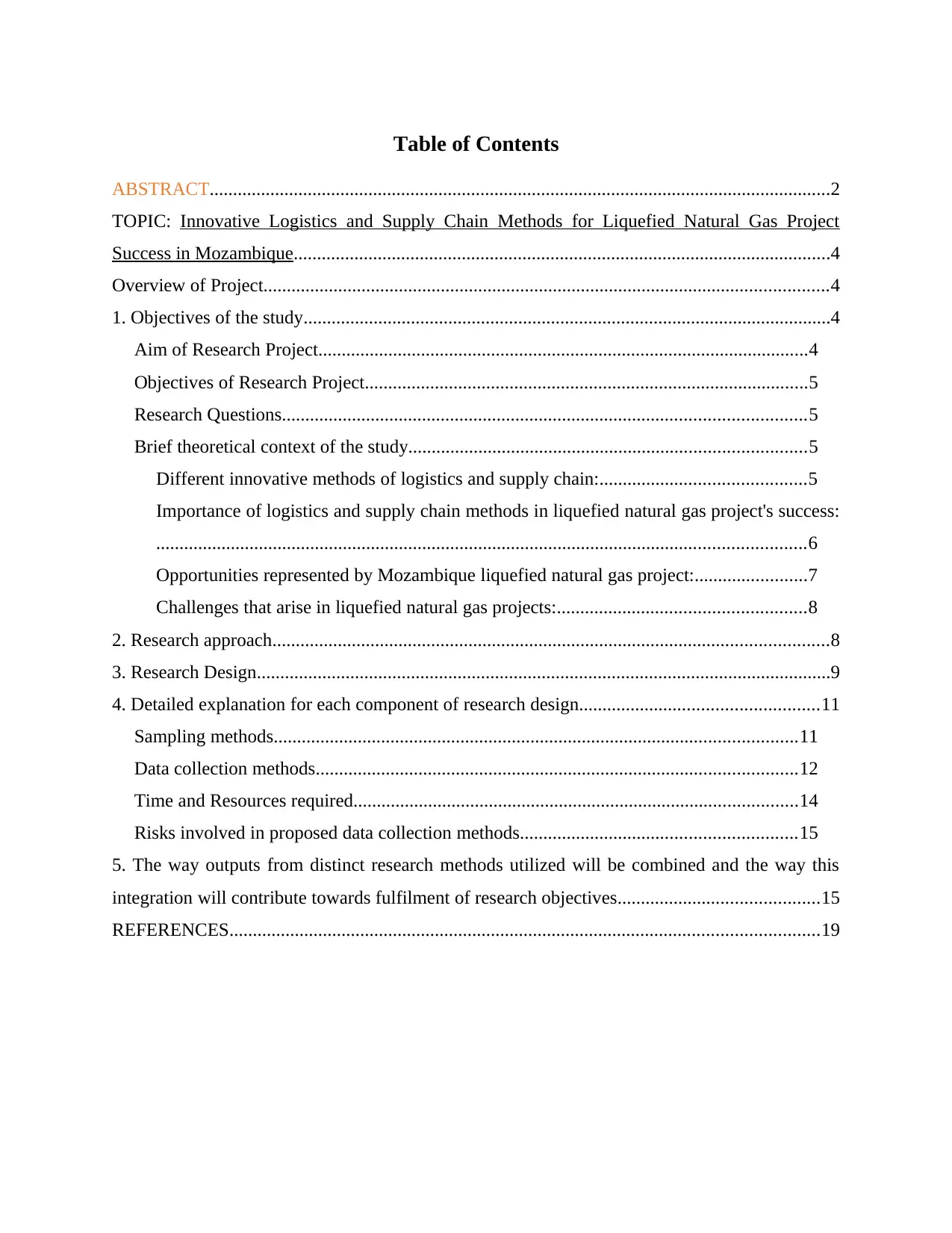
Table of Contents
ABSTRACT.....................................................................................................................................2
TOPIC: Innovative Logistics and Supply Chain Methods for Liquefied Natural Gas Project
Success in Mozambique...................................................................................................................4
Overview of Project.........................................................................................................................4
1. Objectives of the study.................................................................................................................4
Aim of Research Project.........................................................................................................4
Objectives of Research Project...............................................................................................5
Research Questions................................................................................................................5
Brief theoretical context of the study.....................................................................................5
Different innovative methods of logistics and supply chain:............................................5
Importance of logistics and supply chain methods in liquefied natural gas project's success:
...........................................................................................................................................6
Opportunities represented by Mozambique liquefied natural gas project:........................7
Challenges that arise in liquefied natural gas projects:.....................................................8
2. Research approach.......................................................................................................................8
3. Research Design...........................................................................................................................9
4. Detailed explanation for each component of research design...................................................11
Sampling methods................................................................................................................11
Data collection methods.......................................................................................................12
Time and Resources required...............................................................................................14
Risks involved in proposed data collection methods...........................................................15
5. The way outputs from distinct research methods utilized will be combined and the way this
integration will contribute towards fulfilment of research objectives...........................................15
REFERENCES..............................................................................................................................19
ABSTRACT.....................................................................................................................................2
TOPIC: Innovative Logistics and Supply Chain Methods for Liquefied Natural Gas Project
Success in Mozambique...................................................................................................................4
Overview of Project.........................................................................................................................4
1. Objectives of the study.................................................................................................................4
Aim of Research Project.........................................................................................................4
Objectives of Research Project...............................................................................................5
Research Questions................................................................................................................5
Brief theoretical context of the study.....................................................................................5
Different innovative methods of logistics and supply chain:............................................5
Importance of logistics and supply chain methods in liquefied natural gas project's success:
...........................................................................................................................................6
Opportunities represented by Mozambique liquefied natural gas project:........................7
Challenges that arise in liquefied natural gas projects:.....................................................8
2. Research approach.......................................................................................................................8
3. Research Design...........................................................................................................................9
4. Detailed explanation for each component of research design...................................................11
Sampling methods................................................................................................................11
Data collection methods.......................................................................................................12
Time and Resources required...............................................................................................14
Risks involved in proposed data collection methods...........................................................15
5. The way outputs from distinct research methods utilized will be combined and the way this
integration will contribute towards fulfilment of research objectives...........................................15
REFERENCES..............................................................................................................................19
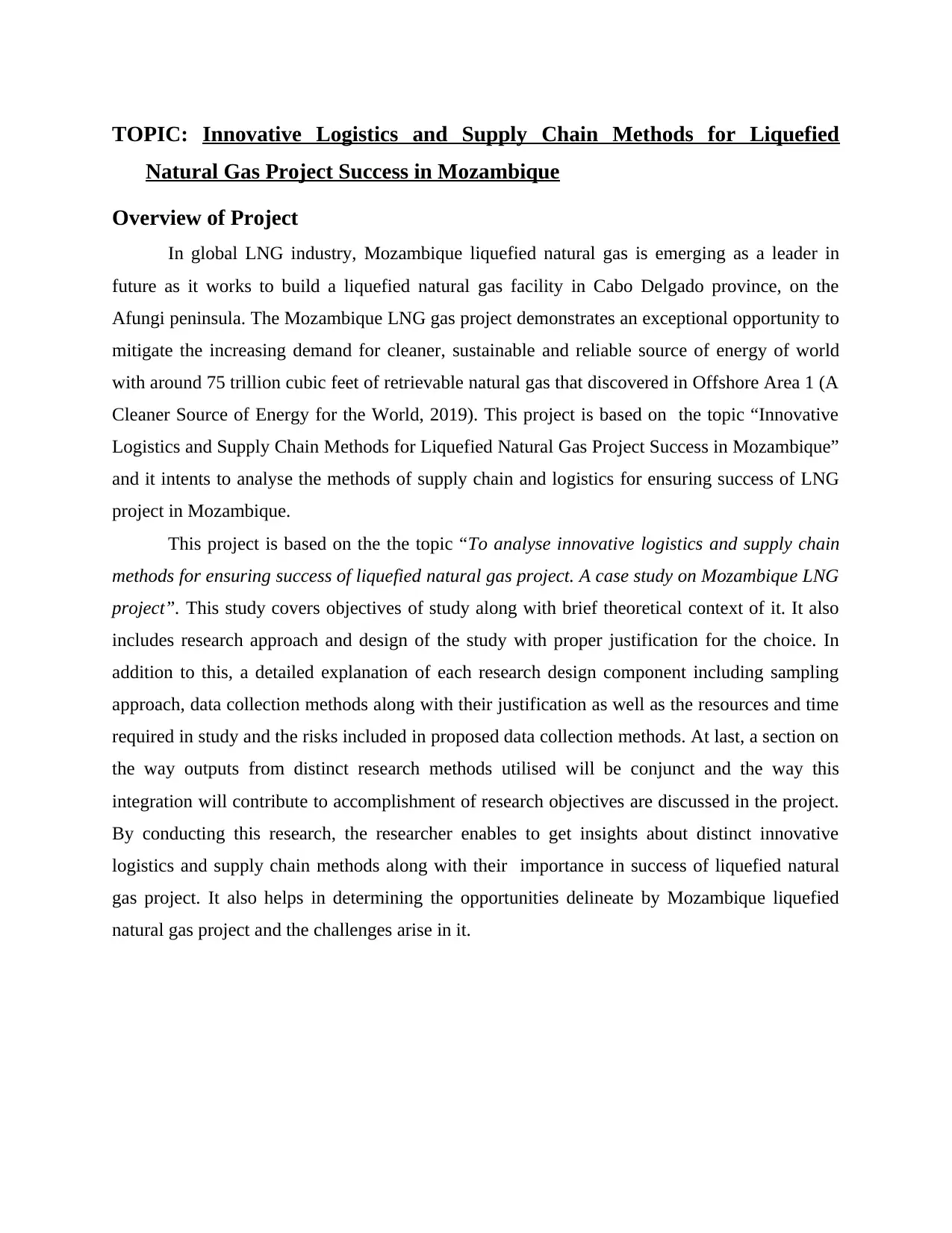
TOPIC: Innovative Logistics and Supply Chain Methods for Liquefied
Natural Gas Project Success in Mozambique
Overview of Project
In global LNG industry, Mozambique liquefied natural gas is emerging as a leader in
future as it works to build a liquefied natural gas facility in Cabo Delgado province, on the
Afungi peninsula. The Mozambique LNG gas project demonstrates an exceptional opportunity to
mitigate the increasing demand for cleaner, sustainable and reliable source of energy of world
with around 75 trillion cubic feet of retrievable natural gas that discovered in Offshore Area 1 (A
Cleaner Source of Energy for the World, 2019). This project is based on the topic “Innovative
Logistics and Supply Chain Methods for Liquefied Natural Gas Project Success in Mozambique”
and it intents to analyse the methods of supply chain and logistics for ensuring success of LNG
project in Mozambique.
This project is based on the the topic “To analyse innovative logistics and supply chain
methods for ensuring success of liquefied natural gas project. A case study on Mozambique LNG
project”. This study covers objectives of study along with brief theoretical context of it. It also
includes research approach and design of the study with proper justification for the choice. In
addition to this, a detailed explanation of each research design component including sampling
approach, data collection methods along with their justification as well as the resources and time
required in study and the risks included in proposed data collection methods. At last, a section on
the way outputs from distinct research methods utilised will be conjunct and the way this
integration will contribute to accomplishment of research objectives are discussed in the project.
By conducting this research, the researcher enables to get insights about distinct innovative
logistics and supply chain methods along with their importance in success of liquefied natural
gas project. It also helps in determining the opportunities delineate by Mozambique liquefied
natural gas project and the challenges arise in it.
Natural Gas Project Success in Mozambique
Overview of Project
In global LNG industry, Mozambique liquefied natural gas is emerging as a leader in
future as it works to build a liquefied natural gas facility in Cabo Delgado province, on the
Afungi peninsula. The Mozambique LNG gas project demonstrates an exceptional opportunity to
mitigate the increasing demand for cleaner, sustainable and reliable source of energy of world
with around 75 trillion cubic feet of retrievable natural gas that discovered in Offshore Area 1 (A
Cleaner Source of Energy for the World, 2019). This project is based on the topic “Innovative
Logistics and Supply Chain Methods for Liquefied Natural Gas Project Success in Mozambique”
and it intents to analyse the methods of supply chain and logistics for ensuring success of LNG
project in Mozambique.
This project is based on the the topic “To analyse innovative logistics and supply chain
methods for ensuring success of liquefied natural gas project. A case study on Mozambique LNG
project”. This study covers objectives of study along with brief theoretical context of it. It also
includes research approach and design of the study with proper justification for the choice. In
addition to this, a detailed explanation of each research design component including sampling
approach, data collection methods along with their justification as well as the resources and time
required in study and the risks included in proposed data collection methods. At last, a section on
the way outputs from distinct research methods utilised will be conjunct and the way this
integration will contribute to accomplishment of research objectives are discussed in the project.
By conducting this research, the researcher enables to get insights about distinct innovative
logistics and supply chain methods along with their importance in success of liquefied natural
gas project. It also helps in determining the opportunities delineate by Mozambique liquefied
natural gas project and the challenges arise in it.
Secure Best Marks with AI Grader
Need help grading? Try our AI Grader for instant feedback on your assignments.
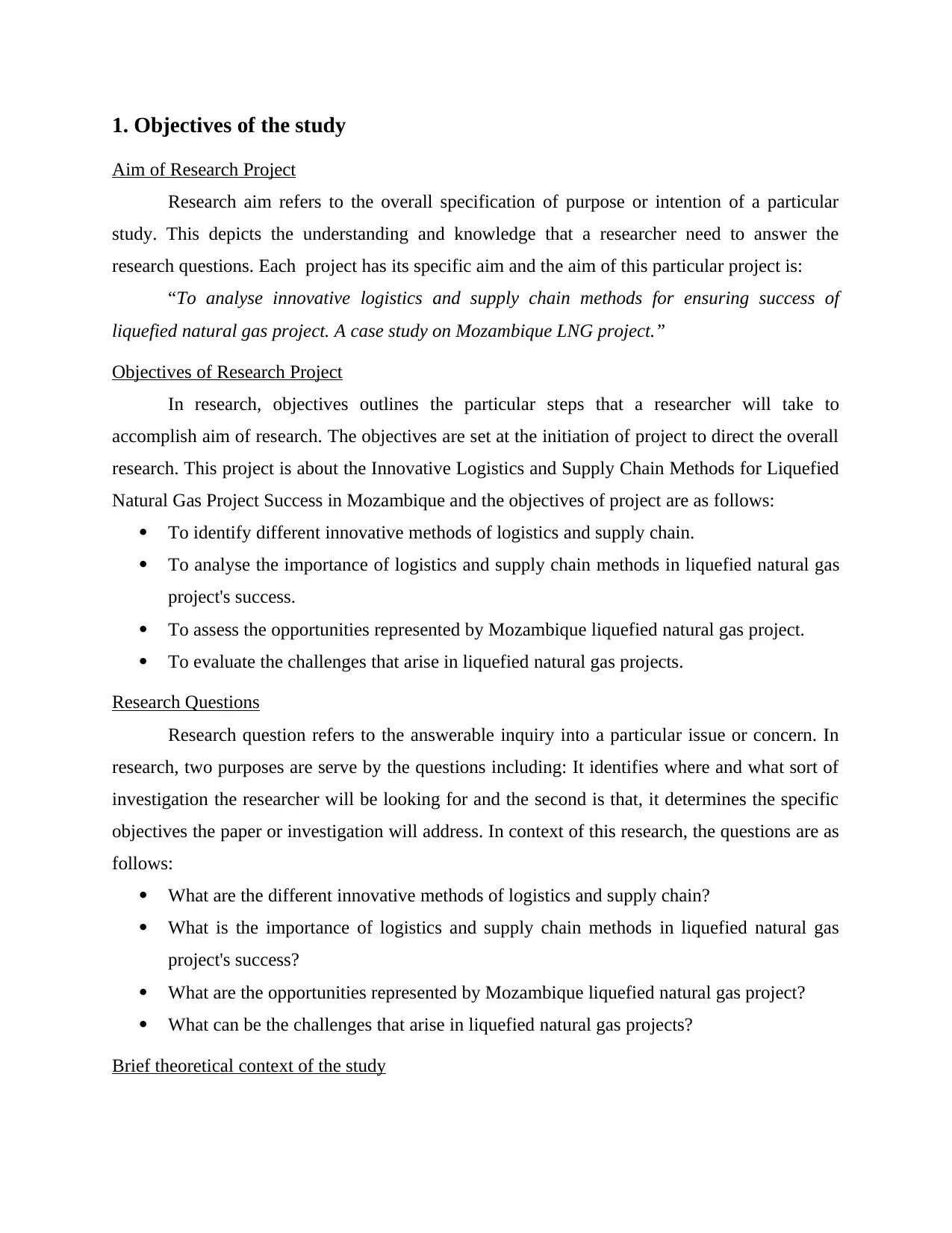
1. Objectives of the study
Aim of Research Project
Research aim refers to the overall specification of purpose or intention of a particular
study. This depicts the understanding and knowledge that a researcher need to answer the
research questions. Each project has its specific aim and the aim of this particular project is:
“To analyse innovative logistics and supply chain methods for ensuring success of
liquefied natural gas project. A case study on Mozambique LNG project.”
Objectives of Research Project
In research, objectives outlines the particular steps that a researcher will take to
accomplish aim of research. The objectives are set at the initiation of project to direct the overall
research. This project is about the Innovative Logistics and Supply Chain Methods for Liquefied
Natural Gas Project Success in Mozambique and the objectives of project are as follows:
To identify different innovative methods of logistics and supply chain.
To analyse the importance of logistics and supply chain methods in liquefied natural gas
project's success.
To assess the opportunities represented by Mozambique liquefied natural gas project.
To evaluate the challenges that arise in liquefied natural gas projects.
Research Questions
Research question refers to the answerable inquiry into a particular issue or concern. In
research, two purposes are serve by the questions including: It identifies where and what sort of
investigation the researcher will be looking for and the second is that, it determines the specific
objectives the paper or investigation will address. In context of this research, the questions are as
follows:
What are the different innovative methods of logistics and supply chain?
What is the importance of logistics and supply chain methods in liquefied natural gas
project's success?
What are the opportunities represented by Mozambique liquefied natural gas project?
What can be the challenges that arise in liquefied natural gas projects?
Brief theoretical context of the study
Aim of Research Project
Research aim refers to the overall specification of purpose or intention of a particular
study. This depicts the understanding and knowledge that a researcher need to answer the
research questions. Each project has its specific aim and the aim of this particular project is:
“To analyse innovative logistics and supply chain methods for ensuring success of
liquefied natural gas project. A case study on Mozambique LNG project.”
Objectives of Research Project
In research, objectives outlines the particular steps that a researcher will take to
accomplish aim of research. The objectives are set at the initiation of project to direct the overall
research. This project is about the Innovative Logistics and Supply Chain Methods for Liquefied
Natural Gas Project Success in Mozambique and the objectives of project are as follows:
To identify different innovative methods of logistics and supply chain.
To analyse the importance of logistics and supply chain methods in liquefied natural gas
project's success.
To assess the opportunities represented by Mozambique liquefied natural gas project.
To evaluate the challenges that arise in liquefied natural gas projects.
Research Questions
Research question refers to the answerable inquiry into a particular issue or concern. In
research, two purposes are serve by the questions including: It identifies where and what sort of
investigation the researcher will be looking for and the second is that, it determines the specific
objectives the paper or investigation will address. In context of this research, the questions are as
follows:
What are the different innovative methods of logistics and supply chain?
What is the importance of logistics and supply chain methods in liquefied natural gas
project's success?
What are the opportunities represented by Mozambique liquefied natural gas project?
What can be the challenges that arise in liquefied natural gas projects?
Brief theoretical context of the study
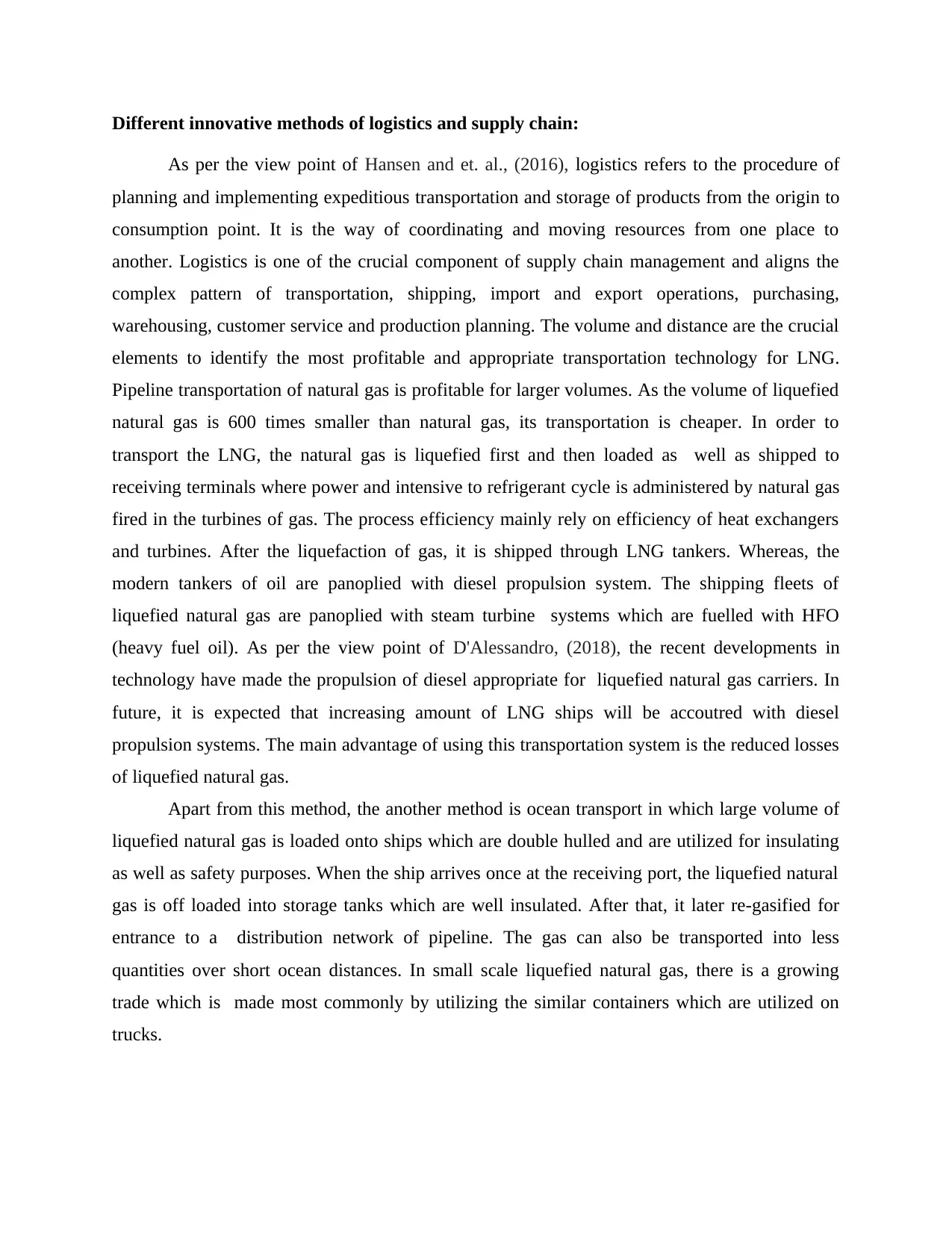
Different innovative methods of logistics and supply chain:
As per the view point of Hansen and et. al., (2016), logistics refers to the procedure of
planning and implementing expeditious transportation and storage of products from the origin to
consumption point. It is the way of coordinating and moving resources from one place to
another. Logistics is one of the crucial component of supply chain management and aligns the
complex pattern of transportation, shipping, import and export operations, purchasing,
warehousing, customer service and production planning. The volume and distance are the crucial
elements to identify the most profitable and appropriate transportation technology for LNG.
Pipeline transportation of natural gas is profitable for larger volumes. As the volume of liquefied
natural gas is 600 times smaller than natural gas, its transportation is cheaper. In order to
transport the LNG, the natural gas is liquefied first and then loaded as well as shipped to
receiving terminals where power and intensive to refrigerant cycle is administered by natural gas
fired in the turbines of gas. The process efficiency mainly rely on efficiency of heat exchangers
and turbines. After the liquefaction of gas, it is shipped through LNG tankers. Whereas, the
modern tankers of oil are panoplied with diesel propulsion system. The shipping fleets of
liquefied natural gas are panoplied with steam turbine systems which are fuelled with HFO
(heavy fuel oil). As per the view point of D'Alessandro, (2018), the recent developments in
technology have made the propulsion of diesel appropriate for liquefied natural gas carriers. In
future, it is expected that increasing amount of LNG ships will be accoutred with diesel
propulsion systems. The main advantage of using this transportation system is the reduced losses
of liquefied natural gas.
Apart from this method, the another method is ocean transport in which large volume of
liquefied natural gas is loaded onto ships which are double hulled and are utilized for insulating
as well as safety purposes. When the ship arrives once at the receiving port, the liquefied natural
gas is off loaded into storage tanks which are well insulated. After that, it later re-gasified for
entrance to a distribution network of pipeline. The gas can also be transported into less
quantities over short ocean distances. In small scale liquefied natural gas, there is a growing
trade which is made most commonly by utilizing the similar containers which are utilized on
trucks.
As per the view point of Hansen and et. al., (2016), logistics refers to the procedure of
planning and implementing expeditious transportation and storage of products from the origin to
consumption point. It is the way of coordinating and moving resources from one place to
another. Logistics is one of the crucial component of supply chain management and aligns the
complex pattern of transportation, shipping, import and export operations, purchasing,
warehousing, customer service and production planning. The volume and distance are the crucial
elements to identify the most profitable and appropriate transportation technology for LNG.
Pipeline transportation of natural gas is profitable for larger volumes. As the volume of liquefied
natural gas is 600 times smaller than natural gas, its transportation is cheaper. In order to
transport the LNG, the natural gas is liquefied first and then loaded as well as shipped to
receiving terminals where power and intensive to refrigerant cycle is administered by natural gas
fired in the turbines of gas. The process efficiency mainly rely on efficiency of heat exchangers
and turbines. After the liquefaction of gas, it is shipped through LNG tankers. Whereas, the
modern tankers of oil are panoplied with diesel propulsion system. The shipping fleets of
liquefied natural gas are panoplied with steam turbine systems which are fuelled with HFO
(heavy fuel oil). As per the view point of D'Alessandro, (2018), the recent developments in
technology have made the propulsion of diesel appropriate for liquefied natural gas carriers. In
future, it is expected that increasing amount of LNG ships will be accoutred with diesel
propulsion systems. The main advantage of using this transportation system is the reduced losses
of liquefied natural gas.
Apart from this method, the another method is ocean transport in which large volume of
liquefied natural gas is loaded onto ships which are double hulled and are utilized for insulating
as well as safety purposes. When the ship arrives once at the receiving port, the liquefied natural
gas is off loaded into storage tanks which are well insulated. After that, it later re-gasified for
entrance to a distribution network of pipeline. The gas can also be transported into less
quantities over short ocean distances. In small scale liquefied natural gas, there is a growing
trade which is made most commonly by utilizing the similar containers which are utilized on
trucks.

Importance of logistics and supply chain methods in liquefied natural gas project's success:
Good supply chain and logistics methods are important for the success of liquefied
natural gas project as these projects are massive undertakings along with huge number of
construction workers on site at the time of project execution. Apart from this, the another reason
behind importance of logistics and supply chain in LNG project success is that the new wave of
these projects are in challenging locations and numerous projects are being constructed in
conterminous locations that put stress on local suppliers and workers and leads to rise cost
sharply. As per the view point of Mulcahy, (2015), for any LPG project, the hydrocarbons supply
for liquefaction and processing is crucial and can be considered as significant part of operational
stage. The project of liquefied natural gas may be integrated vertically. In it, a single venture
comprehend upstream supply. Supply chain plays very crucial role in transportation of liquefied
natural gas from one place to another. It helps in developing networks and is necessary for
operation of liquefaction plant. Logistics and supply chain methods helps in creating value for
the project named as “Liquefied Natural Gas Project in Mozambique”. It helps in delivering the
supply of LPG on time and meeting the needs and expectations of customers. It also helps in
fulfilling the purpose of providing cleaner source of energy to the entire world which highly
contributes in the success of Liquefied Natural Gas Project in Mozambique.
Opportunities represented by Mozambique liquefied natural gas project:
As per views of Roe, (2018), it has been identified that project of Mozambique based on
liquefied natural gas refers to a cleaner source of Energy of the World. It is also emerged as
future leader within global LNG industry, because it mainly works to develop clear fuel energy
facility, especially on Afguni Peninsula. Having approx. 75 trillion cubic feet natural gas which
is recoverable has been discovered within Offshore Area 1, represents the extraordinary
opportunity of Mozambique LNG Project for meeting the increasing demand of sustainable,
reliable as well as cleaner source of energy. Furthermore, favourable central geographic location
of this country shows that this nation is well positioned also to meet the demands of people
belongs from Atlantic as well as Asia-Pacific markets. Along with this, respective project of
Mozambique is also committed to meet ever-growing demand for energy within Middle East and
sub-continent of India. Moreover, project makers of this nation are committed to work in
collaboration with communities and Mozambican government officials, for safely develop the
Good supply chain and logistics methods are important for the success of liquefied
natural gas project as these projects are massive undertakings along with huge number of
construction workers on site at the time of project execution. Apart from this, the another reason
behind importance of logistics and supply chain in LNG project success is that the new wave of
these projects are in challenging locations and numerous projects are being constructed in
conterminous locations that put stress on local suppliers and workers and leads to rise cost
sharply. As per the view point of Mulcahy, (2015), for any LPG project, the hydrocarbons supply
for liquefaction and processing is crucial and can be considered as significant part of operational
stage. The project of liquefied natural gas may be integrated vertically. In it, a single venture
comprehend upstream supply. Supply chain plays very crucial role in transportation of liquefied
natural gas from one place to another. It helps in developing networks and is necessary for
operation of liquefaction plant. Logistics and supply chain methods helps in creating value for
the project named as “Liquefied Natural Gas Project in Mozambique”. It helps in delivering the
supply of LPG on time and meeting the needs and expectations of customers. It also helps in
fulfilling the purpose of providing cleaner source of energy to the entire world which highly
contributes in the success of Liquefied Natural Gas Project in Mozambique.
Opportunities represented by Mozambique liquefied natural gas project:
As per views of Roe, (2018), it has been identified that project of Mozambique based on
liquefied natural gas refers to a cleaner source of Energy of the World. It is also emerged as
future leader within global LNG industry, because it mainly works to develop clear fuel energy
facility, especially on Afguni Peninsula. Having approx. 75 trillion cubic feet natural gas which
is recoverable has been discovered within Offshore Area 1, represents the extraordinary
opportunity of Mozambique LNG Project for meeting the increasing demand of sustainable,
reliable as well as cleaner source of energy. Furthermore, favourable central geographic location
of this country shows that this nation is well positioned also to meet the demands of people
belongs from Atlantic as well as Asia-Pacific markets. Along with this, respective project of
Mozambique is also committed to meet ever-growing demand for energy within Middle East and
sub-continent of India. Moreover, project makers of this nation are committed to work in
collaboration with communities and Mozambican government officials, for safely develop the
Paraphrase This Document
Need a fresh take? Get an instant paraphrase of this document with our AI Paraphraser
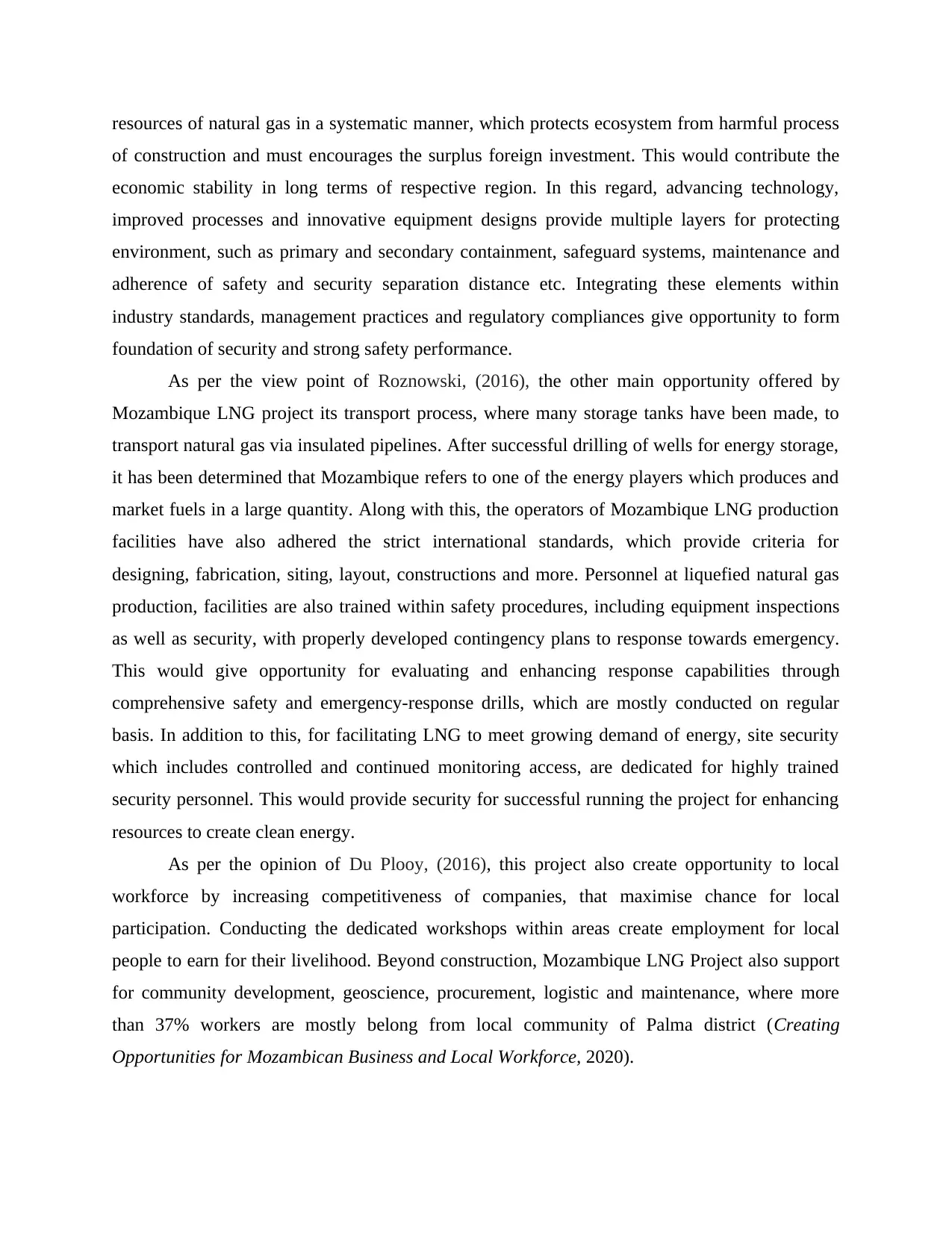
resources of natural gas in a systematic manner, which protects ecosystem from harmful process
of construction and must encourages the surplus foreign investment. This would contribute the
economic stability in long terms of respective region. In this regard, advancing technology,
improved processes and innovative equipment designs provide multiple layers for protecting
environment, such as primary and secondary containment, safeguard systems, maintenance and
adherence of safety and security separation distance etc. Integrating these elements within
industry standards, management practices and regulatory compliances give opportunity to form
foundation of security and strong safety performance.
As per the view point of Roznowski, (2016), the other main opportunity offered by
Mozambique LNG project its transport process, where many storage tanks have been made, to
transport natural gas via insulated pipelines. After successful drilling of wells for energy storage,
it has been determined that Mozambique refers to one of the energy players which produces and
market fuels in a large quantity. Along with this, the operators of Mozambique LNG production
facilities have also adhered the strict international standards, which provide criteria for
designing, fabrication, siting, layout, constructions and more. Personnel at liquefied natural gas
production, facilities are also trained within safety procedures, including equipment inspections
as well as security, with properly developed contingency plans to response towards emergency.
This would give opportunity for evaluating and enhancing response capabilities through
comprehensive safety and emergency-response drills, which are mostly conducted on regular
basis. In addition to this, for facilitating LNG to meet growing demand of energy, site security
which includes controlled and continued monitoring access, are dedicated for highly trained
security personnel. This would provide security for successful running the project for enhancing
resources to create clean energy.
As per the opinion of Du Plooy, (2016), this project also create opportunity to local
workforce by increasing competitiveness of companies, that maximise chance for local
participation. Conducting the dedicated workshops within areas create employment for local
people to earn for their livelihood. Beyond construction, Mozambique LNG Project also support
for community development, geoscience, procurement, logistic and maintenance, where more
than 37% workers are mostly belong from local community of Palma district (Creating
Opportunities for Mozambican Business and Local Workforce, 2020).
of construction and must encourages the surplus foreign investment. This would contribute the
economic stability in long terms of respective region. In this regard, advancing technology,
improved processes and innovative equipment designs provide multiple layers for protecting
environment, such as primary and secondary containment, safeguard systems, maintenance and
adherence of safety and security separation distance etc. Integrating these elements within
industry standards, management practices and regulatory compliances give opportunity to form
foundation of security and strong safety performance.
As per the view point of Roznowski, (2016), the other main opportunity offered by
Mozambique LNG project its transport process, where many storage tanks have been made, to
transport natural gas via insulated pipelines. After successful drilling of wells for energy storage,
it has been determined that Mozambique refers to one of the energy players which produces and
market fuels in a large quantity. Along with this, the operators of Mozambique LNG production
facilities have also adhered the strict international standards, which provide criteria for
designing, fabrication, siting, layout, constructions and more. Personnel at liquefied natural gas
production, facilities are also trained within safety procedures, including equipment inspections
as well as security, with properly developed contingency plans to response towards emergency.
This would give opportunity for evaluating and enhancing response capabilities through
comprehensive safety and emergency-response drills, which are mostly conducted on regular
basis. In addition to this, for facilitating LNG to meet growing demand of energy, site security
which includes controlled and continued monitoring access, are dedicated for highly trained
security personnel. This would provide security for successful running the project for enhancing
resources to create clean energy.
As per the opinion of Du Plooy, (2016), this project also create opportunity to local
workforce by increasing competitiveness of companies, that maximise chance for local
participation. Conducting the dedicated workshops within areas create employment for local
people to earn for their livelihood. Beyond construction, Mozambique LNG Project also support
for community development, geoscience, procurement, logistic and maintenance, where more
than 37% workers are mostly belong from local community of Palma district (Creating
Opportunities for Mozambican Business and Local Workforce, 2020).
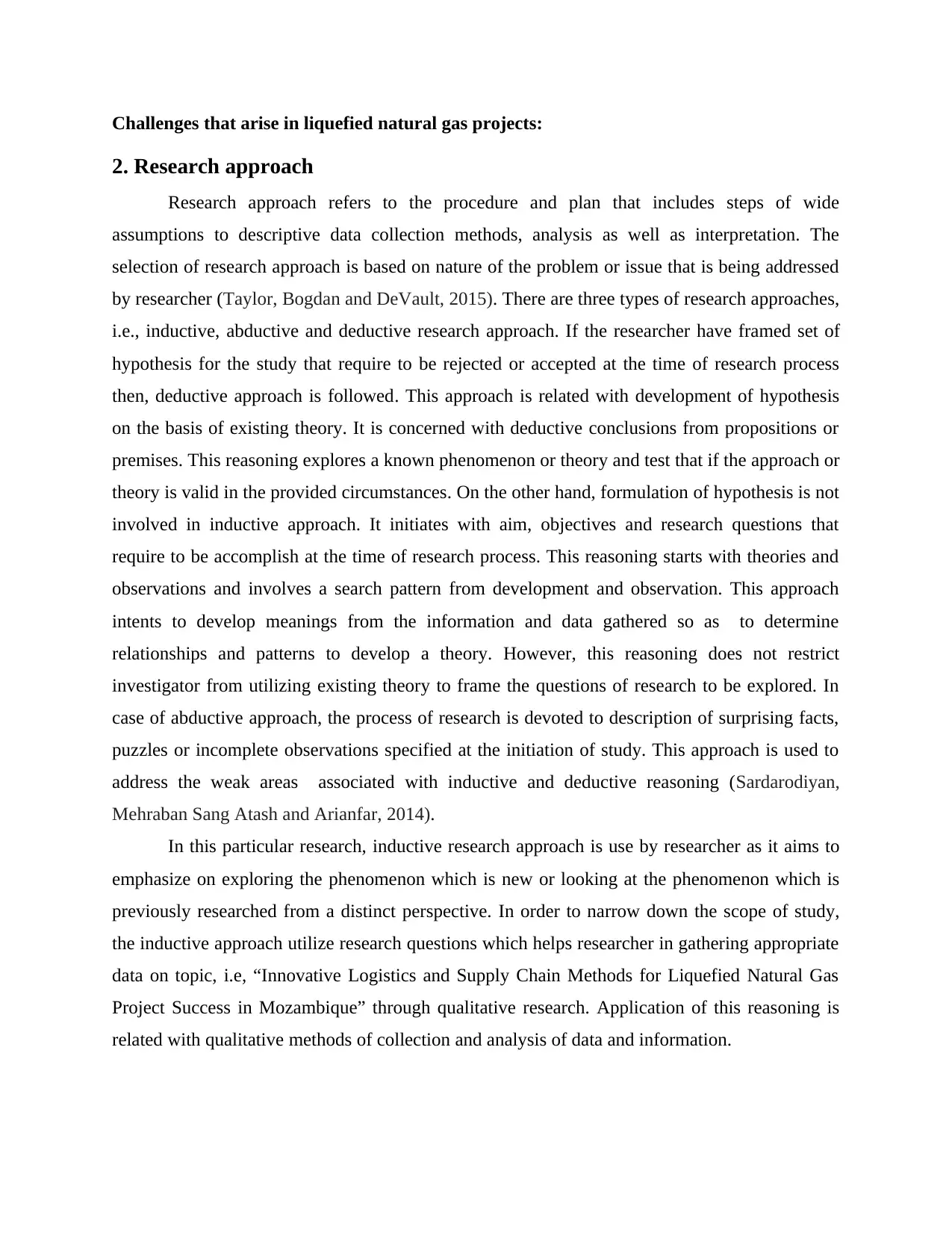
Challenges that arise in liquefied natural gas projects:
2. Research approach
Research approach refers to the procedure and plan that includes steps of wide
assumptions to descriptive data collection methods, analysis as well as interpretation. The
selection of research approach is based on nature of the problem or issue that is being addressed
by researcher (Taylor, Bogdan and DeVault, 2015). There are three types of research approaches,
i.e., inductive, abductive and deductive research approach. If the researcher have framed set of
hypothesis for the study that require to be rejected or accepted at the time of research process
then, deductive approach is followed. This approach is related with development of hypothesis
on the basis of existing theory. It is concerned with deductive conclusions from propositions or
premises. This reasoning explores a known phenomenon or theory and test that if the approach or
theory is valid in the provided circumstances. On the other hand, formulation of hypothesis is not
involved in inductive approach. It initiates with aim, objectives and research questions that
require to be accomplish at the time of research process. This reasoning starts with theories and
observations and involves a search pattern from development and observation. This approach
intents to develop meanings from the information and data gathered so as to determine
relationships and patterns to develop a theory. However, this reasoning does not restrict
investigator from utilizing existing theory to frame the questions of research to be explored. In
case of abductive approach, the process of research is devoted to description of surprising facts,
puzzles or incomplete observations specified at the initiation of study. This approach is used to
address the weak areas associated with inductive and deductive reasoning (Sardarodiyan,
Mehraban Sang Atash and Arianfar, 2014).
In this particular research, inductive research approach is use by researcher as it aims to
emphasize on exploring the phenomenon which is new or looking at the phenomenon which is
previously researched from a distinct perspective. In order to narrow down the scope of study,
the inductive approach utilize research questions which helps researcher in gathering appropriate
data on topic, i.e, “Innovative Logistics and Supply Chain Methods for Liquefied Natural Gas
Project Success in Mozambique” through qualitative research. Application of this reasoning is
related with qualitative methods of collection and analysis of data and information.
2. Research approach
Research approach refers to the procedure and plan that includes steps of wide
assumptions to descriptive data collection methods, analysis as well as interpretation. The
selection of research approach is based on nature of the problem or issue that is being addressed
by researcher (Taylor, Bogdan and DeVault, 2015). There are three types of research approaches,
i.e., inductive, abductive and deductive research approach. If the researcher have framed set of
hypothesis for the study that require to be rejected or accepted at the time of research process
then, deductive approach is followed. This approach is related with development of hypothesis
on the basis of existing theory. It is concerned with deductive conclusions from propositions or
premises. This reasoning explores a known phenomenon or theory and test that if the approach or
theory is valid in the provided circumstances. On the other hand, formulation of hypothesis is not
involved in inductive approach. It initiates with aim, objectives and research questions that
require to be accomplish at the time of research process. This reasoning starts with theories and
observations and involves a search pattern from development and observation. This approach
intents to develop meanings from the information and data gathered so as to determine
relationships and patterns to develop a theory. However, this reasoning does not restrict
investigator from utilizing existing theory to frame the questions of research to be explored. In
case of abductive approach, the process of research is devoted to description of surprising facts,
puzzles or incomplete observations specified at the initiation of study. This approach is used to
address the weak areas associated with inductive and deductive reasoning (Sardarodiyan,
Mehraban Sang Atash and Arianfar, 2014).
In this particular research, inductive research approach is use by researcher as it aims to
emphasize on exploring the phenomenon which is new or looking at the phenomenon which is
previously researched from a distinct perspective. In order to narrow down the scope of study,
the inductive approach utilize research questions which helps researcher in gathering appropriate
data on topic, i.e, “Innovative Logistics and Supply Chain Methods for Liquefied Natural Gas
Project Success in Mozambique” through qualitative research. Application of this reasoning is
related with qualitative methods of collection and analysis of data and information.
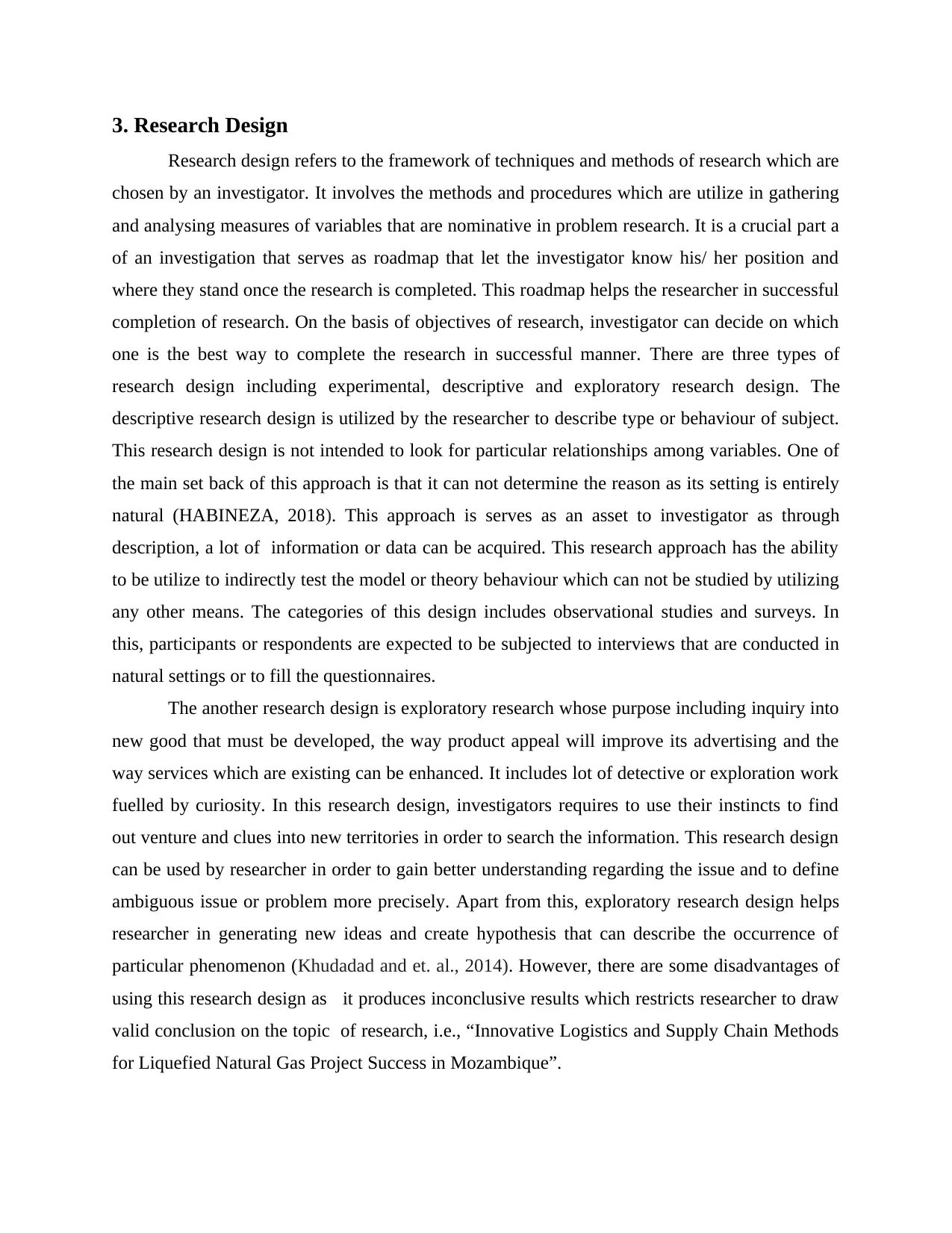
3. Research Design
Research design refers to the framework of techniques and methods of research which are
chosen by an investigator. It involves the methods and procedures which are utilize in gathering
and analysing measures of variables that are nominative in problem research. It is a crucial part a
of an investigation that serves as roadmap that let the investigator know his/ her position and
where they stand once the research is completed. This roadmap helps the researcher in successful
completion of research. On the basis of objectives of research, investigator can decide on which
one is the best way to complete the research in successful manner. There are three types of
research design including experimental, descriptive and exploratory research design. The
descriptive research design is utilized by the researcher to describe type or behaviour of subject.
This research design is not intended to look for particular relationships among variables. One of
the main set back of this approach is that it can not determine the reason as its setting is entirely
natural (HABINEZA, 2018). This approach is serves as an asset to investigator as through
description, a lot of information or data can be acquired. This research approach has the ability
to be utilize to indirectly test the model or theory behaviour which can not be studied by utilizing
any other means. The categories of this design includes observational studies and surveys. In
this, participants or respondents are expected to be subjected to interviews that are conducted in
natural settings or to fill the questionnaires.
The another research design is exploratory research whose purpose including inquiry into
new good that must be developed, the way product appeal will improve its advertising and the
way services which are existing can be enhanced. It includes lot of detective or exploration work
fuelled by curiosity. In this research design, investigators requires to use their instincts to find
out venture and clues into new territories in order to search the information. This research design
can be used by researcher in order to gain better understanding regarding the issue and to define
ambiguous issue or problem more precisely. Apart from this, exploratory research design helps
researcher in generating new ideas and create hypothesis that can describe the occurrence of
particular phenomenon (Khudadad and et. al., 2014). However, there are some disadvantages of
using this research design as it produces inconclusive results which restricts researcher to draw
valid conclusion on the topic of research, i.e., “Innovative Logistics and Supply Chain Methods
for Liquefied Natural Gas Project Success in Mozambique”.
Research design refers to the framework of techniques and methods of research which are
chosen by an investigator. It involves the methods and procedures which are utilize in gathering
and analysing measures of variables that are nominative in problem research. It is a crucial part a
of an investigation that serves as roadmap that let the investigator know his/ her position and
where they stand once the research is completed. This roadmap helps the researcher in successful
completion of research. On the basis of objectives of research, investigator can decide on which
one is the best way to complete the research in successful manner. There are three types of
research design including experimental, descriptive and exploratory research design. The
descriptive research design is utilized by the researcher to describe type or behaviour of subject.
This research design is not intended to look for particular relationships among variables. One of
the main set back of this approach is that it can not determine the reason as its setting is entirely
natural (HABINEZA, 2018). This approach is serves as an asset to investigator as through
description, a lot of information or data can be acquired. This research approach has the ability
to be utilize to indirectly test the model or theory behaviour which can not be studied by utilizing
any other means. The categories of this design includes observational studies and surveys. In
this, participants or respondents are expected to be subjected to interviews that are conducted in
natural settings or to fill the questionnaires.
The another research design is exploratory research whose purpose including inquiry into
new good that must be developed, the way product appeal will improve its advertising and the
way services which are existing can be enhanced. It includes lot of detective or exploration work
fuelled by curiosity. In this research design, investigators requires to use their instincts to find
out venture and clues into new territories in order to search the information. This research design
can be used by researcher in order to gain better understanding regarding the issue and to define
ambiguous issue or problem more precisely. Apart from this, exploratory research design helps
researcher in generating new ideas and create hypothesis that can describe the occurrence of
particular phenomenon (Khudadad and et. al., 2014). However, there are some disadvantages of
using this research design as it produces inconclusive results which restricts researcher to draw
valid conclusion on the topic of research, i.e., “Innovative Logistics and Supply Chain Methods
for Liquefied Natural Gas Project Success in Mozambique”.
Secure Best Marks with AI Grader
Need help grading? Try our AI Grader for instant feedback on your assignments.
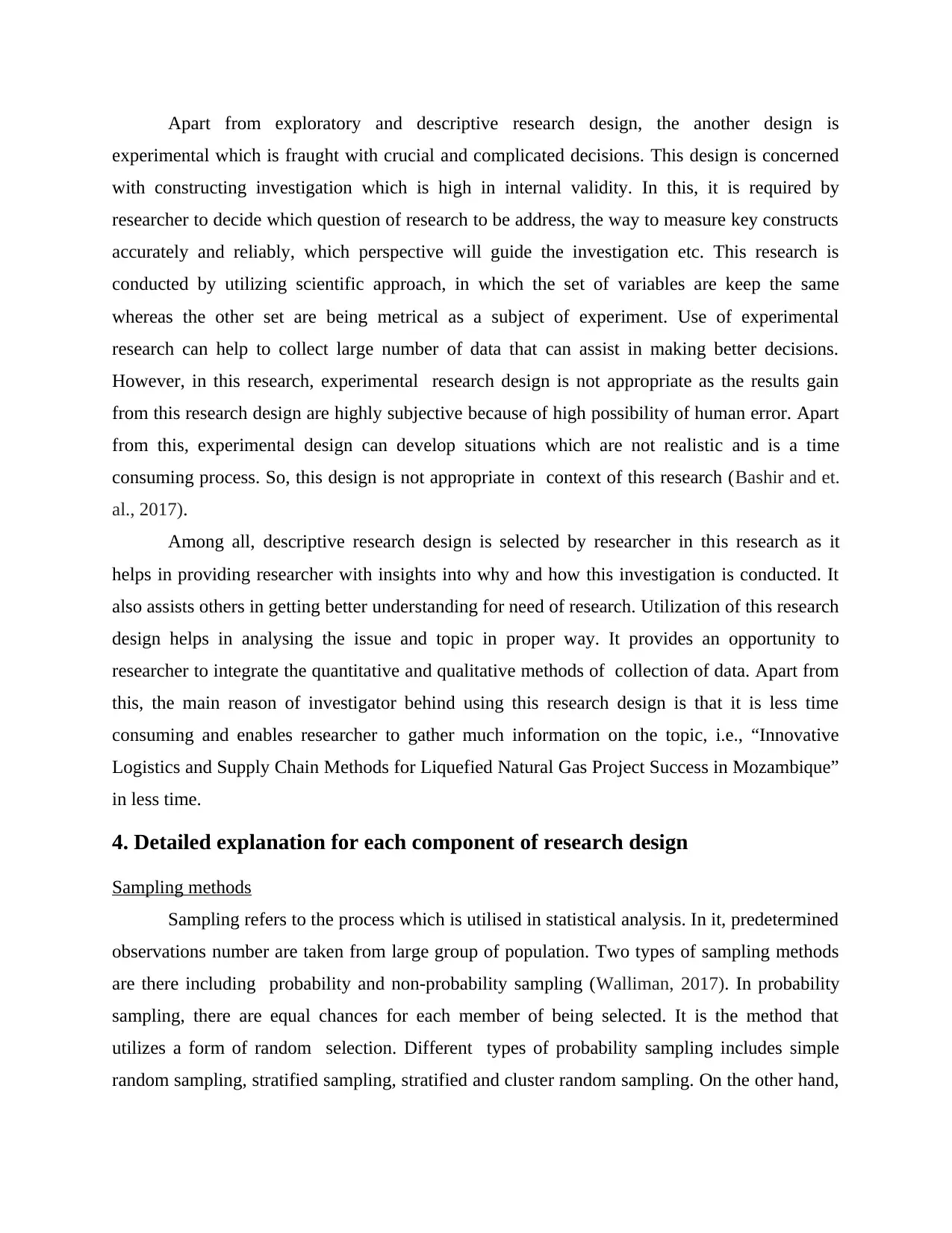
Apart from exploratory and descriptive research design, the another design is
experimental which is fraught with crucial and complicated decisions. This design is concerned
with constructing investigation which is high in internal validity. In this, it is required by
researcher to decide which question of research to be address, the way to measure key constructs
accurately and reliably, which perspective will guide the investigation etc. This research is
conducted by utilizing scientific approach, in which the set of variables are keep the same
whereas the other set are being metrical as a subject of experiment. Use of experimental
research can help to collect large number of data that can assist in making better decisions.
However, in this research, experimental research design is not appropriate as the results gain
from this research design are highly subjective because of high possibility of human error. Apart
from this, experimental design can develop situations which are not realistic and is a time
consuming process. So, this design is not appropriate in context of this research (Bashir and et.
al., 2017).
Among all, descriptive research design is selected by researcher in this research as it
helps in providing researcher with insights into why and how this investigation is conducted. It
also assists others in getting better understanding for need of research. Utilization of this research
design helps in analysing the issue and topic in proper way. It provides an opportunity to
researcher to integrate the quantitative and qualitative methods of collection of data. Apart from
this, the main reason of investigator behind using this research design is that it is less time
consuming and enables researcher to gather much information on the topic, i.e., “Innovative
Logistics and Supply Chain Methods for Liquefied Natural Gas Project Success in Mozambique”
in less time.
4. Detailed explanation for each component of research design
Sampling methods
Sampling refers to the process which is utilised in statistical analysis. In it, predetermined
observations number are taken from large group of population. Two types of sampling methods
are there including probability and non-probability sampling (Walliman, 2017). In probability
sampling, there are equal chances for each member of being selected. It is the method that
utilizes a form of random selection. Different types of probability sampling includes simple
random sampling, stratified sampling, stratified and cluster random sampling. On the other hand,
experimental which is fraught with crucial and complicated decisions. This design is concerned
with constructing investigation which is high in internal validity. In this, it is required by
researcher to decide which question of research to be address, the way to measure key constructs
accurately and reliably, which perspective will guide the investigation etc. This research is
conducted by utilizing scientific approach, in which the set of variables are keep the same
whereas the other set are being metrical as a subject of experiment. Use of experimental
research can help to collect large number of data that can assist in making better decisions.
However, in this research, experimental research design is not appropriate as the results gain
from this research design are highly subjective because of high possibility of human error. Apart
from this, experimental design can develop situations which are not realistic and is a time
consuming process. So, this design is not appropriate in context of this research (Bashir and et.
al., 2017).
Among all, descriptive research design is selected by researcher in this research as it
helps in providing researcher with insights into why and how this investigation is conducted. It
also assists others in getting better understanding for need of research. Utilization of this research
design helps in analysing the issue and topic in proper way. It provides an opportunity to
researcher to integrate the quantitative and qualitative methods of collection of data. Apart from
this, the main reason of investigator behind using this research design is that it is less time
consuming and enables researcher to gather much information on the topic, i.e., “Innovative
Logistics and Supply Chain Methods for Liquefied Natural Gas Project Success in Mozambique”
in less time.
4. Detailed explanation for each component of research design
Sampling methods
Sampling refers to the process which is utilised in statistical analysis. In it, predetermined
observations number are taken from large group of population. Two types of sampling methods
are there including probability and non-probability sampling (Walliman, 2017). In probability
sampling, there are equal chances for each member of being selected. It is the method that
utilizes a form of random selection. Different types of probability sampling includes simple
random sampling, stratified sampling, stratified and cluster random sampling. On the other hand,
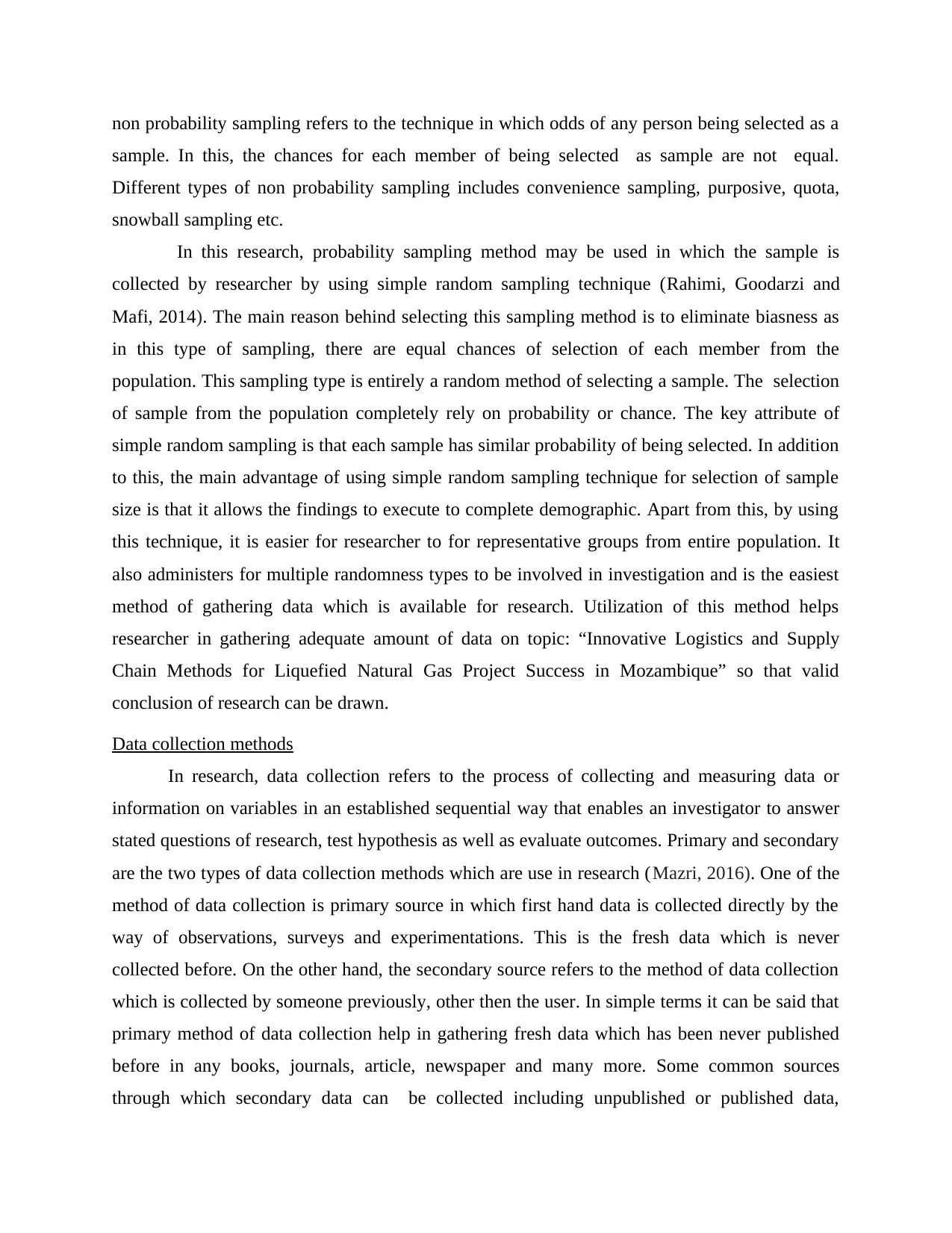
non probability sampling refers to the technique in which odds of any person being selected as a
sample. In this, the chances for each member of being selected as sample are not equal.
Different types of non probability sampling includes convenience sampling, purposive, quota,
snowball sampling etc.
In this research, probability sampling method may be used in which the sample is
collected by researcher by using simple random sampling technique (Rahimi, Goodarzi and
Mafi, 2014). The main reason behind selecting this sampling method is to eliminate biasness as
in this type of sampling, there are equal chances of selection of each member from the
population. This sampling type is entirely a random method of selecting a sample. The selection
of sample from the population completely rely on probability or chance. The key attribute of
simple random sampling is that each sample has similar probability of being selected. In addition
to this, the main advantage of using simple random sampling technique for selection of sample
size is that it allows the findings to execute to complete demographic. Apart from this, by using
this technique, it is easier for researcher to for representative groups from entire population. It
also administers for multiple randomness types to be involved in investigation and is the easiest
method of gathering data which is available for research. Utilization of this method helps
researcher in gathering adequate amount of data on topic: “Innovative Logistics and Supply
Chain Methods for Liquefied Natural Gas Project Success in Mozambique” so that valid
conclusion of research can be drawn.
Data collection methods
In research, data collection refers to the process of collecting and measuring data or
information on variables in an established sequential way that enables an investigator to answer
stated questions of research, test hypothesis as well as evaluate outcomes. Primary and secondary
are the two types of data collection methods which are use in research (Mazri, 2016). One of the
method of data collection is primary source in which first hand data is collected directly by the
way of observations, surveys and experimentations. This is the fresh data which is never
collected before. On the other hand, the secondary source refers to the method of data collection
which is collected by someone previously, other then the user. In simple terms it can be said that
primary method of data collection help in gathering fresh data which has been never published
before in any books, journals, article, newspaper and many more. Some common sources
through which secondary data can be collected including unpublished or published data,
sample. In this, the chances for each member of being selected as sample are not equal.
Different types of non probability sampling includes convenience sampling, purposive, quota,
snowball sampling etc.
In this research, probability sampling method may be used in which the sample is
collected by researcher by using simple random sampling technique (Rahimi, Goodarzi and
Mafi, 2014). The main reason behind selecting this sampling method is to eliminate biasness as
in this type of sampling, there are equal chances of selection of each member from the
population. This sampling type is entirely a random method of selecting a sample. The selection
of sample from the population completely rely on probability or chance. The key attribute of
simple random sampling is that each sample has similar probability of being selected. In addition
to this, the main advantage of using simple random sampling technique for selection of sample
size is that it allows the findings to execute to complete demographic. Apart from this, by using
this technique, it is easier for researcher to for representative groups from entire population. It
also administers for multiple randomness types to be involved in investigation and is the easiest
method of gathering data which is available for research. Utilization of this method helps
researcher in gathering adequate amount of data on topic: “Innovative Logistics and Supply
Chain Methods for Liquefied Natural Gas Project Success in Mozambique” so that valid
conclusion of research can be drawn.
Data collection methods
In research, data collection refers to the process of collecting and measuring data or
information on variables in an established sequential way that enables an investigator to answer
stated questions of research, test hypothesis as well as evaluate outcomes. Primary and secondary
are the two types of data collection methods which are use in research (Mazri, 2016). One of the
method of data collection is primary source in which first hand data is collected directly by the
way of observations, surveys and experimentations. This is the fresh data which is never
collected before. On the other hand, the secondary source refers to the method of data collection
which is collected by someone previously, other then the user. In simple terms it can be said that
primary method of data collection help in gathering fresh data which has been never published
before in any books, journals, article, newspaper and many more. Some common sources
through which secondary data can be collected including unpublished or published data,
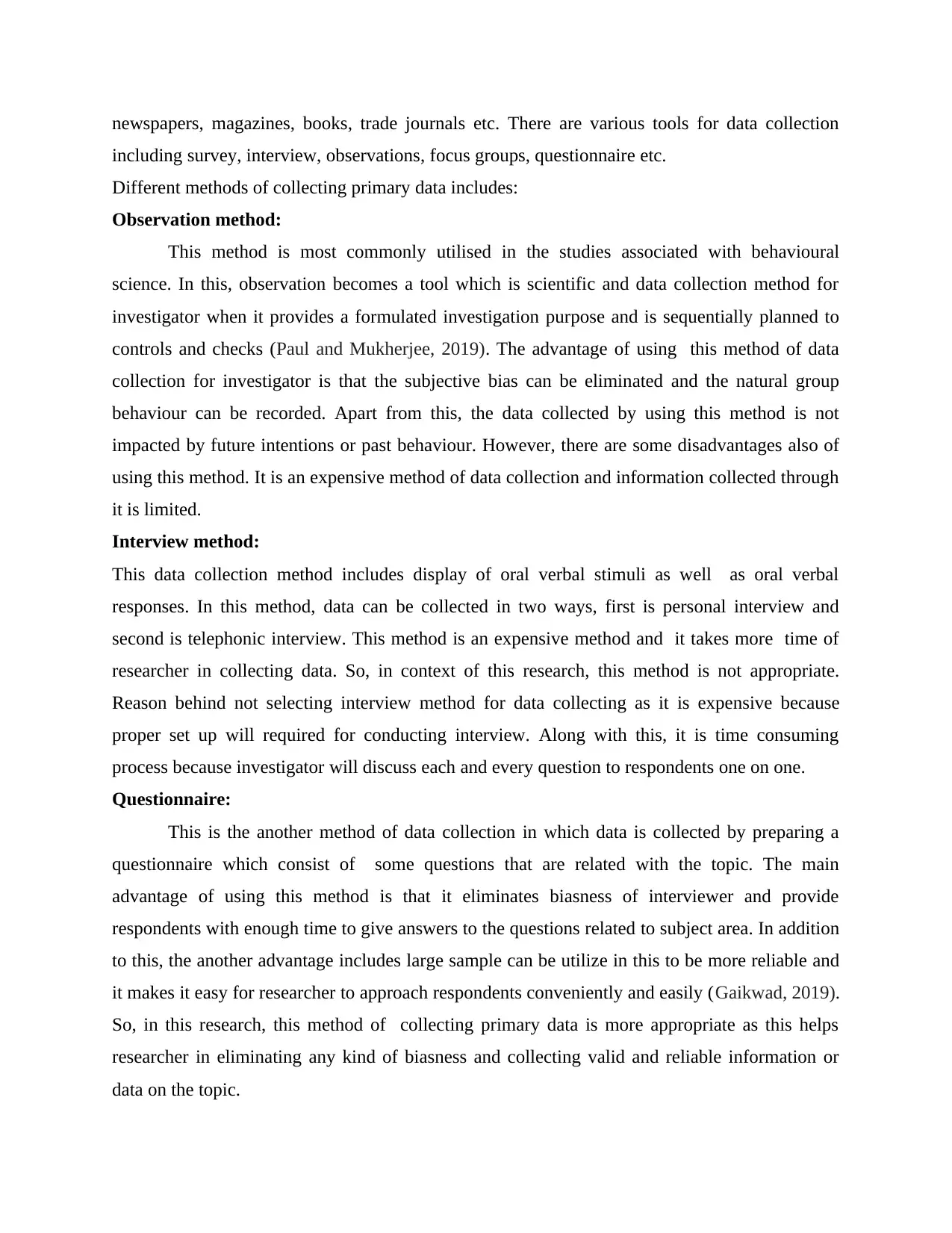
newspapers, magazines, books, trade journals etc. There are various tools for data collection
including survey, interview, observations, focus groups, questionnaire etc.
Different methods of collecting primary data includes:
Observation method:
This method is most commonly utilised in the studies associated with behavioural
science. In this, observation becomes a tool which is scientific and data collection method for
investigator when it provides a formulated investigation purpose and is sequentially planned to
controls and checks (Paul and Mukherjee, 2019). The advantage of using this method of data
collection for investigator is that the subjective bias can be eliminated and the natural group
behaviour can be recorded. Apart from this, the data collected by using this method is not
impacted by future intentions or past behaviour. However, there are some disadvantages also of
using this method. It is an expensive method of data collection and information collected through
it is limited.
Interview method:
This data collection method includes display of oral verbal stimuli as well as oral verbal
responses. In this method, data can be collected in two ways, first is personal interview and
second is telephonic interview. This method is an expensive method and it takes more time of
researcher in collecting data. So, in context of this research, this method is not appropriate.
Reason behind not selecting interview method for data collecting as it is expensive because
proper set up will required for conducting interview. Along with this, it is time consuming
process because investigator will discuss each and every question to respondents one on one.
Questionnaire:
This is the another method of data collection in which data is collected by preparing a
questionnaire which consist of some questions that are related with the topic. The main
advantage of using this method is that it eliminates biasness of interviewer and provide
respondents with enough time to give answers to the questions related to subject area. In addition
to this, the another advantage includes large sample can be utilize in this to be more reliable and
it makes it easy for researcher to approach respondents conveniently and easily (Gaikwad, 2019).
So, in this research, this method of collecting primary data is more appropriate as this helps
researcher in eliminating any kind of biasness and collecting valid and reliable information or
data on the topic.
including survey, interview, observations, focus groups, questionnaire etc.
Different methods of collecting primary data includes:
Observation method:
This method is most commonly utilised in the studies associated with behavioural
science. In this, observation becomes a tool which is scientific and data collection method for
investigator when it provides a formulated investigation purpose and is sequentially planned to
controls and checks (Paul and Mukherjee, 2019). The advantage of using this method of data
collection for investigator is that the subjective bias can be eliminated and the natural group
behaviour can be recorded. Apart from this, the data collected by using this method is not
impacted by future intentions or past behaviour. However, there are some disadvantages also of
using this method. It is an expensive method of data collection and information collected through
it is limited.
Interview method:
This data collection method includes display of oral verbal stimuli as well as oral verbal
responses. In this method, data can be collected in two ways, first is personal interview and
second is telephonic interview. This method is an expensive method and it takes more time of
researcher in collecting data. So, in context of this research, this method is not appropriate.
Reason behind not selecting interview method for data collecting as it is expensive because
proper set up will required for conducting interview. Along with this, it is time consuming
process because investigator will discuss each and every question to respondents one on one.
Questionnaire:
This is the another method of data collection in which data is collected by preparing a
questionnaire which consist of some questions that are related with the topic. The main
advantage of using this method is that it eliminates biasness of interviewer and provide
respondents with enough time to give answers to the questions related to subject area. In addition
to this, the another advantage includes large sample can be utilize in this to be more reliable and
it makes it easy for researcher to approach respondents conveniently and easily (Gaikwad, 2019).
So, in this research, this method of collecting primary data is more appropriate as this helps
researcher in eliminating any kind of biasness and collecting valid and reliable information or
data on the topic.
Paraphrase This Document
Need a fresh take? Get an instant paraphrase of this document with our AI Paraphraser
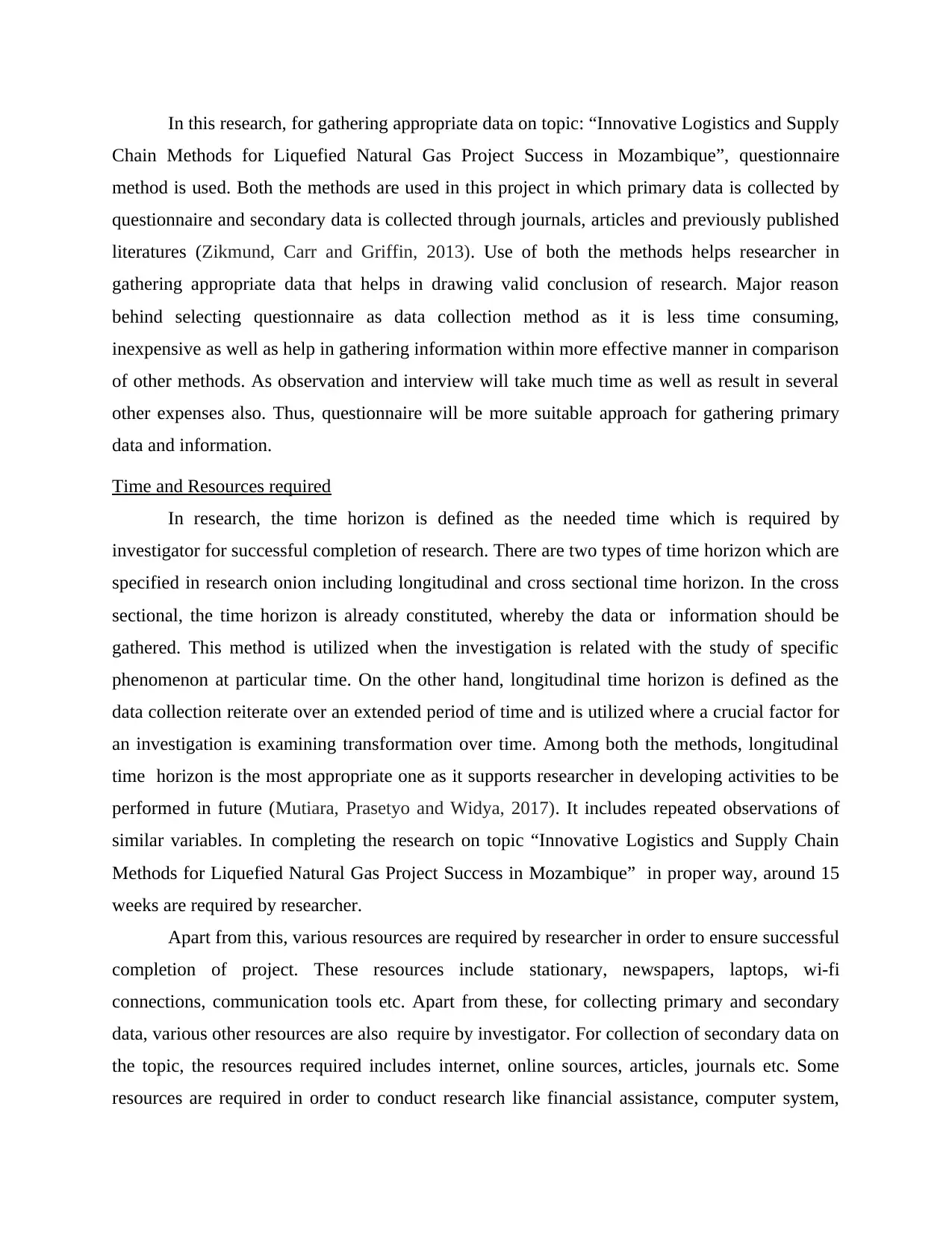
In this research, for gathering appropriate data on topic: “Innovative Logistics and Supply
Chain Methods for Liquefied Natural Gas Project Success in Mozambique”, questionnaire
method is used. Both the methods are used in this project in which primary data is collected by
questionnaire and secondary data is collected through journals, articles and previously published
literatures (Zikmund, Carr and Griffin, 2013). Use of both the methods helps researcher in
gathering appropriate data that helps in drawing valid conclusion of research. Major reason
behind selecting questionnaire as data collection method as it is less time consuming,
inexpensive as well as help in gathering information within more effective manner in comparison
of other methods. As observation and interview will take much time as well as result in several
other expenses also. Thus, questionnaire will be more suitable approach for gathering primary
data and information.
Time and Resources required
In research, the time horizon is defined as the needed time which is required by
investigator for successful completion of research. There are two types of time horizon which are
specified in research onion including longitudinal and cross sectional time horizon. In the cross
sectional, the time horizon is already constituted, whereby the data or information should be
gathered. This method is utilized when the investigation is related with the study of specific
phenomenon at particular time. On the other hand, longitudinal time horizon is defined as the
data collection reiterate over an extended period of time and is utilized where a crucial factor for
an investigation is examining transformation over time. Among both the methods, longitudinal
time horizon is the most appropriate one as it supports researcher in developing activities to be
performed in future (Mutiara, Prasetyo and Widya, 2017). It includes repeated observations of
similar variables. In completing the research on topic “Innovative Logistics and Supply Chain
Methods for Liquefied Natural Gas Project Success in Mozambique” in proper way, around 15
weeks are required by researcher.
Apart from this, various resources are required by researcher in order to ensure successful
completion of project. These resources include stationary, newspapers, laptops, wi-fi
connections, communication tools etc. Apart from these, for collecting primary and secondary
data, various other resources are also require by investigator. For collection of secondary data on
the topic, the resources required includes internet, online sources, articles, journals etc. Some
resources are required in order to conduct research like financial assistance, computer system,
Chain Methods for Liquefied Natural Gas Project Success in Mozambique”, questionnaire
method is used. Both the methods are used in this project in which primary data is collected by
questionnaire and secondary data is collected through journals, articles and previously published
literatures (Zikmund, Carr and Griffin, 2013). Use of both the methods helps researcher in
gathering appropriate data that helps in drawing valid conclusion of research. Major reason
behind selecting questionnaire as data collection method as it is less time consuming,
inexpensive as well as help in gathering information within more effective manner in comparison
of other methods. As observation and interview will take much time as well as result in several
other expenses also. Thus, questionnaire will be more suitable approach for gathering primary
data and information.
Time and Resources required
In research, the time horizon is defined as the needed time which is required by
investigator for successful completion of research. There are two types of time horizon which are
specified in research onion including longitudinal and cross sectional time horizon. In the cross
sectional, the time horizon is already constituted, whereby the data or information should be
gathered. This method is utilized when the investigation is related with the study of specific
phenomenon at particular time. On the other hand, longitudinal time horizon is defined as the
data collection reiterate over an extended period of time and is utilized where a crucial factor for
an investigation is examining transformation over time. Among both the methods, longitudinal
time horizon is the most appropriate one as it supports researcher in developing activities to be
performed in future (Mutiara, Prasetyo and Widya, 2017). It includes repeated observations of
similar variables. In completing the research on topic “Innovative Logistics and Supply Chain
Methods for Liquefied Natural Gas Project Success in Mozambique” in proper way, around 15
weeks are required by researcher.
Apart from this, various resources are required by researcher in order to ensure successful
completion of project. These resources include stationary, newspapers, laptops, wi-fi
connections, communication tools etc. Apart from these, for collecting primary and secondary
data, various other resources are also require by investigator. For collection of secondary data on
the topic, the resources required includes internet, online sources, articles, journals etc. Some
resources are required in order to conduct research like financial assistance, computer system,

human resource etc. With the help of these, adequate data can be gathered appropriately and
stored in proper manner (Weerasin and Akatimagool, 2016). In order to communicate
information in proper way, some communication tools are also required by researcher such as
telephone, e-mails, messages etc. This helps researcher in communicating all the informations
appropriately among the team members and the audiences (Benson, 2019). Among all the
resources, cost, time and communication are consider as major components or resources that
assist an investigator to ensure successful completion of each activity of research in an effective
manner.
Risks involved in proposed data collection methods
In collecting data from primary source, there is high risk involved associated with
validity and reliability of data. Apart from this, the suitability and accuracy of data is also a risk
as there are high possibilities that respondents may provide biased responses. It is very necessary
for the investigator to develop valid and reliable outcomes by conducting research. Apart from
this, in some situation respondents will not answer questions asked by respondents in proper
manner which will give negative impact on findings of investigation. Thus, validity and
reliability are the two crucial aspects that requires to be considered by researcher while
conducting research and collecting data (Boateng, 2016). It is also necessary for the investigator
to maintain confidentiality of data as there are high chances of leakage of crucial information
related to research. At the time of collecting secondary data, high risk is involved. There are high
chances that the data collected from online sources is unauthenticated. So, for satisfying validity
criterion, it is very necessary for researcher to extract information by using authenticate sources
only. When valid and reliable results are drawn, then a only the investigation is said to be
reliable. Apart from this, the research is reliable in nature when the outcomes drawn are similar,
even under the different circumstances. In context of this research, the investigator ensures that
all the informations are gather from authenticated sources and suitable research methods are
adopted in order to carry out the research in an appropriate manner (Siddesha and Uma, 2018).
stored in proper manner (Weerasin and Akatimagool, 2016). In order to communicate
information in proper way, some communication tools are also required by researcher such as
telephone, e-mails, messages etc. This helps researcher in communicating all the informations
appropriately among the team members and the audiences (Benson, 2019). Among all the
resources, cost, time and communication are consider as major components or resources that
assist an investigator to ensure successful completion of each activity of research in an effective
manner.
Risks involved in proposed data collection methods
In collecting data from primary source, there is high risk involved associated with
validity and reliability of data. Apart from this, the suitability and accuracy of data is also a risk
as there are high possibilities that respondents may provide biased responses. It is very necessary
for the investigator to develop valid and reliable outcomes by conducting research. Apart from
this, in some situation respondents will not answer questions asked by respondents in proper
manner which will give negative impact on findings of investigation. Thus, validity and
reliability are the two crucial aspects that requires to be considered by researcher while
conducting research and collecting data (Boateng, 2016). It is also necessary for the investigator
to maintain confidentiality of data as there are high chances of leakage of crucial information
related to research. At the time of collecting secondary data, high risk is involved. There are high
chances that the data collected from online sources is unauthenticated. So, for satisfying validity
criterion, it is very necessary for researcher to extract information by using authenticate sources
only. When valid and reliable results are drawn, then a only the investigation is said to be
reliable. Apart from this, the research is reliable in nature when the outcomes drawn are similar,
even under the different circumstances. In context of this research, the investigator ensures that
all the informations are gather from authenticated sources and suitable research methods are
adopted in order to carry out the research in an appropriate manner (Siddesha and Uma, 2018).
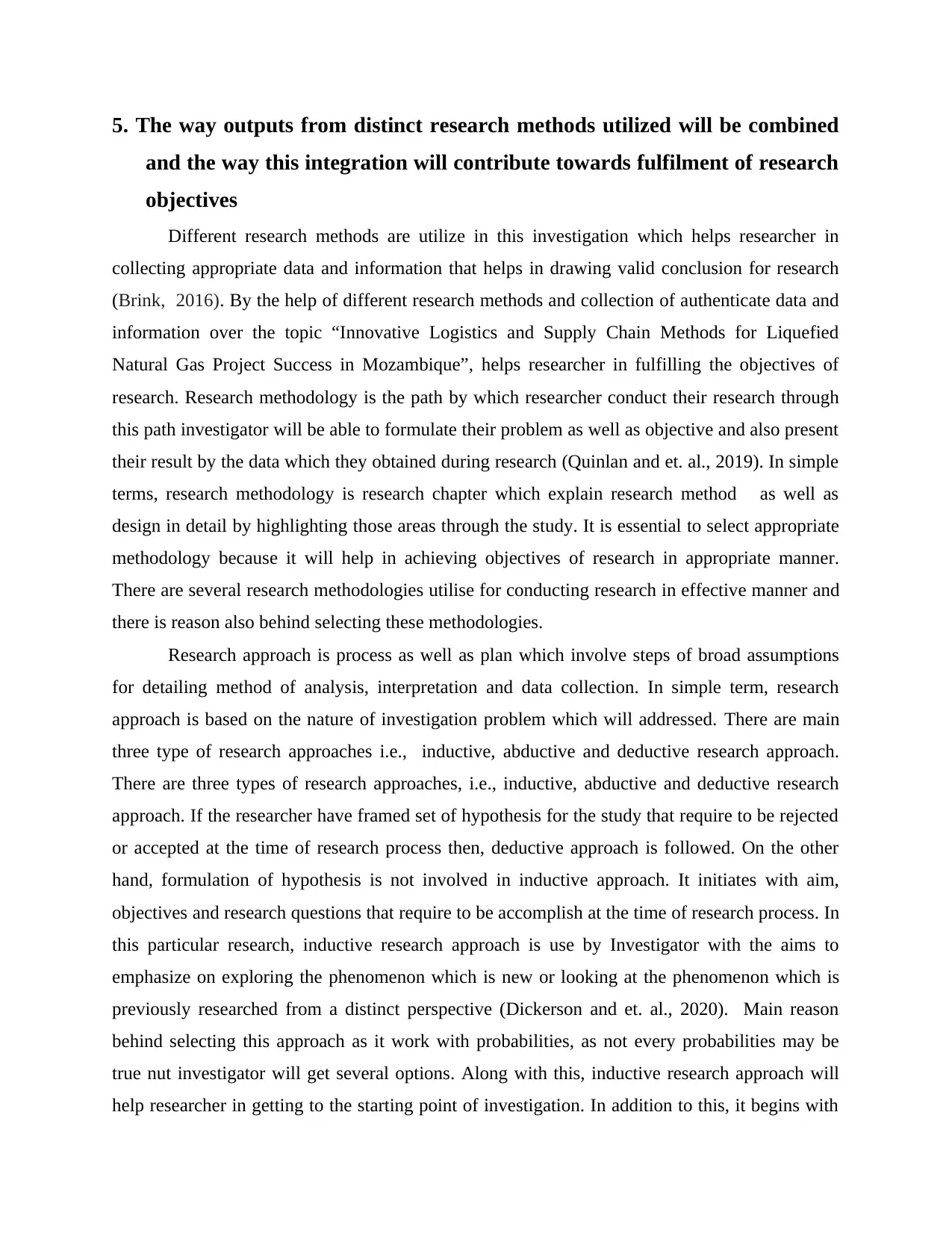
5. The way outputs from distinct research methods utilized will be combined
and the way this integration will contribute towards fulfilment of research
objectives
Different research methods are utilize in this investigation which helps researcher in
collecting appropriate data and information that helps in drawing valid conclusion for research
(Brink, 2016). By the help of different research methods and collection of authenticate data and
information over the topic “Innovative Logistics and Supply Chain Methods for Liquefied
Natural Gas Project Success in Mozambique”, helps researcher in fulfilling the objectives of
research. Research methodology is the path by which researcher conduct their research through
this path investigator will be able to formulate their problem as well as objective and also present
their result by the data which they obtained during research (Quinlan and et. al., 2019). In simple
terms, research methodology is research chapter which explain research method as well as
design in detail by highlighting those areas through the study. It is essential to select appropriate
methodology because it will help in achieving objectives of research in appropriate manner.
There are several research methodologies utilise for conducting research in effective manner and
there is reason also behind selecting these methodologies.
Research approach is process as well as plan which involve steps of broad assumptions
for detailing method of analysis, interpretation and data collection. In simple term, research
approach is based on the nature of investigation problem which will addressed. There are main
three type of research approaches i.e., inductive, abductive and deductive research approach.
There are three types of research approaches, i.e., inductive, abductive and deductive research
approach. If the researcher have framed set of hypothesis for the study that require to be rejected
or accepted at the time of research process then, deductive approach is followed. On the other
hand, formulation of hypothesis is not involved in inductive approach. It initiates with aim,
objectives and research questions that require to be accomplish at the time of research process. In
this particular research, inductive research approach is use by Investigator with the aims to
emphasize on exploring the phenomenon which is new or looking at the phenomenon which is
previously researched from a distinct perspective (Dickerson and et. al., 2020). Main reason
behind selecting this approach as it work with probabilities, as not every probabilities may be
true nut investigator will get several options. Along with this, inductive research approach will
help researcher in getting to the starting point of investigation. In addition to this, it begins with
and the way this integration will contribute towards fulfilment of research
objectives
Different research methods are utilize in this investigation which helps researcher in
collecting appropriate data and information that helps in drawing valid conclusion for research
(Brink, 2016). By the help of different research methods and collection of authenticate data and
information over the topic “Innovative Logistics and Supply Chain Methods for Liquefied
Natural Gas Project Success in Mozambique”, helps researcher in fulfilling the objectives of
research. Research methodology is the path by which researcher conduct their research through
this path investigator will be able to formulate their problem as well as objective and also present
their result by the data which they obtained during research (Quinlan and et. al., 2019). In simple
terms, research methodology is research chapter which explain research method as well as
design in detail by highlighting those areas through the study. It is essential to select appropriate
methodology because it will help in achieving objectives of research in appropriate manner.
There are several research methodologies utilise for conducting research in effective manner and
there is reason also behind selecting these methodologies.
Research approach is process as well as plan which involve steps of broad assumptions
for detailing method of analysis, interpretation and data collection. In simple term, research
approach is based on the nature of investigation problem which will addressed. There are main
three type of research approaches i.e., inductive, abductive and deductive research approach.
There are three types of research approaches, i.e., inductive, abductive and deductive research
approach. If the researcher have framed set of hypothesis for the study that require to be rejected
or accepted at the time of research process then, deductive approach is followed. On the other
hand, formulation of hypothesis is not involved in inductive approach. It initiates with aim,
objectives and research questions that require to be accomplish at the time of research process. In
this particular research, inductive research approach is use by Investigator with the aims to
emphasize on exploring the phenomenon which is new or looking at the phenomenon which is
previously researched from a distinct perspective (Dickerson and et. al., 2020). Main reason
behind selecting this approach as it work with probabilities, as not every probabilities may be
true nut investigator will get several options. Along with this, inductive research approach will
help researcher in getting to the starting point of investigation. In addition to this, it begins with
Secure Best Marks with AI Grader
Need help grading? Try our AI Grader for instant feedback on your assignments.
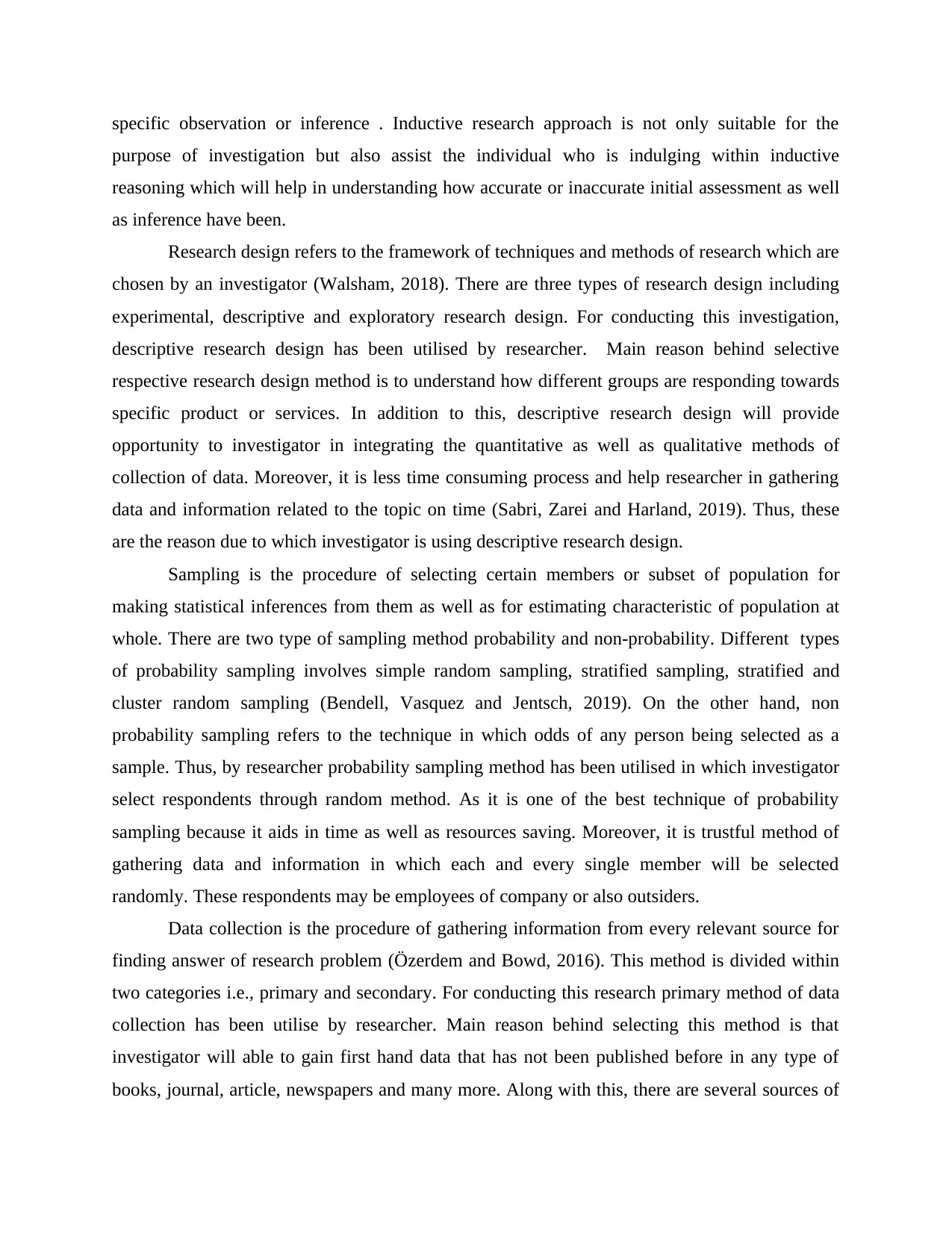
specific observation or inference . Inductive research approach is not only suitable for the
purpose of investigation but also assist the individual who is indulging within inductive
reasoning which will help in understanding how accurate or inaccurate initial assessment as well
as inference have been.
Research design refers to the framework of techniques and methods of research which are
chosen by an investigator (Walsham, 2018). There are three types of research design including
experimental, descriptive and exploratory research design. For conducting this investigation,
descriptive research design has been utilised by researcher. Main reason behind selective
respective research design method is to understand how different groups are responding towards
specific product or services. In addition to this, descriptive research design will provide
opportunity to investigator in integrating the quantitative as well as qualitative methods of
collection of data. Moreover, it is less time consuming process and help researcher in gathering
data and information related to the topic on time (Sabri, Zarei and Harland, 2019). Thus, these
are the reason due to which investigator is using descriptive research design.
Sampling is the procedure of selecting certain members or subset of population for
making statistical inferences from them as well as for estimating characteristic of population at
whole. There are two type of sampling method probability and non-probability. Different types
of probability sampling involves simple random sampling, stratified sampling, stratified and
cluster random sampling (Bendell, Vasquez and Jentsch, 2019). On the other hand, non
probability sampling refers to the technique in which odds of any person being selected as a
sample. Thus, by researcher probability sampling method has been utilised in which investigator
select respondents through random method. As it is one of the best technique of probability
sampling because it aids in time as well as resources saving. Moreover, it is trustful method of
gathering data and information in which each and every single member will be selected
randomly. These respondents may be employees of company or also outsiders.
Data collection is the procedure of gathering information from every relevant source for
finding answer of research problem (Özerdem and Bowd, 2016). This method is divided within
two categories i.e., primary and secondary. For conducting this research primary method of data
collection has been utilise by researcher. Main reason behind selecting this method is that
investigator will able to gain first hand data that has not been published before in any type of
books, journal, article, newspapers and many more. Along with this, there are several sources of
purpose of investigation but also assist the individual who is indulging within inductive
reasoning which will help in understanding how accurate or inaccurate initial assessment as well
as inference have been.
Research design refers to the framework of techniques and methods of research which are
chosen by an investigator (Walsham, 2018). There are three types of research design including
experimental, descriptive and exploratory research design. For conducting this investigation,
descriptive research design has been utilised by researcher. Main reason behind selective
respective research design method is to understand how different groups are responding towards
specific product or services. In addition to this, descriptive research design will provide
opportunity to investigator in integrating the quantitative as well as qualitative methods of
collection of data. Moreover, it is less time consuming process and help researcher in gathering
data and information related to the topic on time (Sabri, Zarei and Harland, 2019). Thus, these
are the reason due to which investigator is using descriptive research design.
Sampling is the procedure of selecting certain members or subset of population for
making statistical inferences from them as well as for estimating characteristic of population at
whole. There are two type of sampling method probability and non-probability. Different types
of probability sampling involves simple random sampling, stratified sampling, stratified and
cluster random sampling (Bendell, Vasquez and Jentsch, 2019). On the other hand, non
probability sampling refers to the technique in which odds of any person being selected as a
sample. Thus, by researcher probability sampling method has been utilised in which investigator
select respondents through random method. As it is one of the best technique of probability
sampling because it aids in time as well as resources saving. Moreover, it is trustful method of
gathering data and information in which each and every single member will be selected
randomly. These respondents may be employees of company or also outsiders.
Data collection is the procedure of gathering information from every relevant source for
finding answer of research problem (Özerdem and Bowd, 2016). This method is divided within
two categories i.e., primary and secondary. For conducting this research primary method of data
collection has been utilise by researcher. Main reason behind selecting this method is that
investigator will able to gain first hand data that has not been published before in any type of
books, journal, article, newspapers and many more. Along with this, there are several sources of
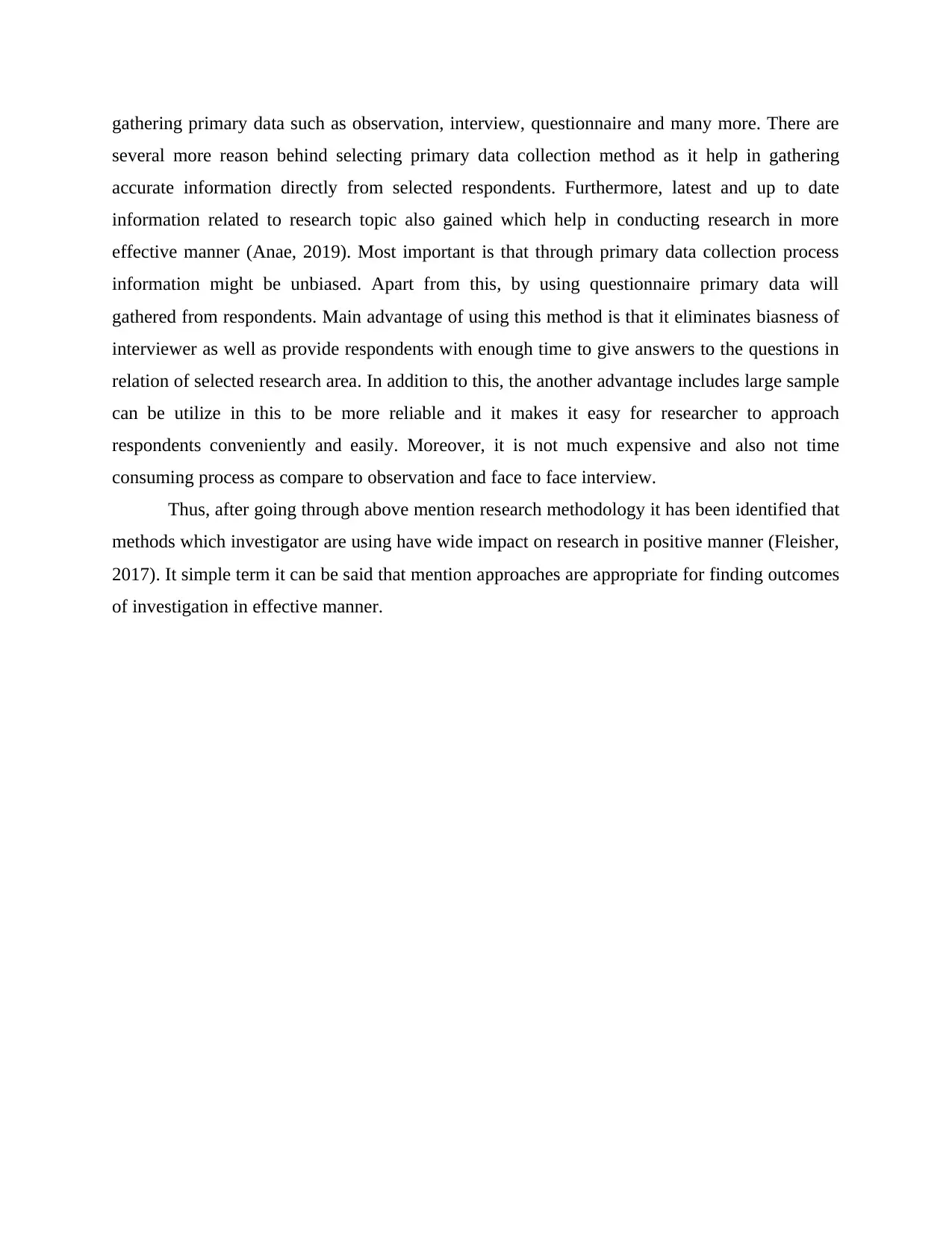
gathering primary data such as observation, interview, questionnaire and many more. There are
several more reason behind selecting primary data collection method as it help in gathering
accurate information directly from selected respondents. Furthermore, latest and up to date
information related to research topic also gained which help in conducting research in more
effective manner (Anae, 2019). Most important is that through primary data collection process
information might be unbiased. Apart from this, by using questionnaire primary data will
gathered from respondents. Main advantage of using this method is that it eliminates biasness of
interviewer as well as provide respondents with enough time to give answers to the questions in
relation of selected research area. In addition to this, the another advantage includes large sample
can be utilize in this to be more reliable and it makes it easy for researcher to approach
respondents conveniently and easily. Moreover, it is not much expensive and also not time
consuming process as compare to observation and face to face interview.
Thus, after going through above mention research methodology it has been identified that
methods which investigator are using have wide impact on research in positive manner (Fleisher,
2017). It simple term it can be said that mention approaches are appropriate for finding outcomes
of investigation in effective manner.
several more reason behind selecting primary data collection method as it help in gathering
accurate information directly from selected respondents. Furthermore, latest and up to date
information related to research topic also gained which help in conducting research in more
effective manner (Anae, 2019). Most important is that through primary data collection process
information might be unbiased. Apart from this, by using questionnaire primary data will
gathered from respondents. Main advantage of using this method is that it eliminates biasness of
interviewer as well as provide respondents with enough time to give answers to the questions in
relation of selected research area. In addition to this, the another advantage includes large sample
can be utilize in this to be more reliable and it makes it easy for researcher to approach
respondents conveniently and easily. Moreover, it is not much expensive and also not time
consuming process as compare to observation and face to face interview.
Thus, after going through above mention research methodology it has been identified that
methods which investigator are using have wide impact on research in positive manner (Fleisher,
2017). It simple term it can be said that mention approaches are appropriate for finding outcomes
of investigation in effective manner.
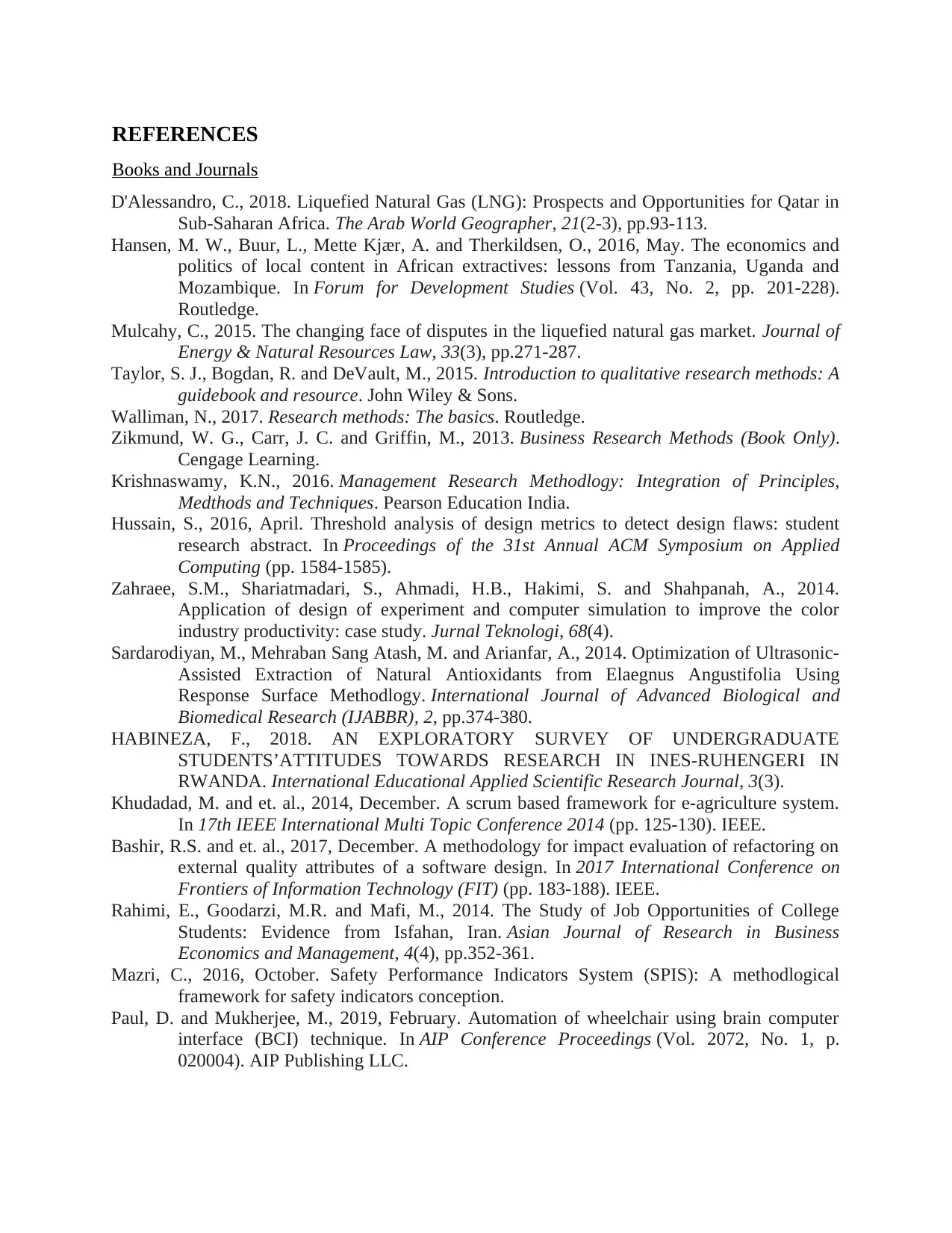
REFERENCES
Books and Journals
D'Alessandro, C., 2018. Liquefied Natural Gas (LNG): Prospects and Opportunities for Qatar in
Sub-Saharan Africa. The Arab World Geographer, 21(2-3), pp.93-113.
Hansen, M. W., Buur, L., Mette Kjær, A. and Therkildsen, O., 2016, May. The economics and
politics of local content in African extractives: lessons from Tanzania, Uganda and
Mozambique. In Forum for Development Studies (Vol. 43, No. 2, pp. 201-228).
Routledge.
Mulcahy, C., 2015. The changing face of disputes in the liquefied natural gas market. Journal of
Energy & Natural Resources Law, 33(3), pp.271-287.
Taylor, S. J., Bogdan, R. and DeVault, M., 2015. Introduction to qualitative research methods: A
guidebook and resource. John Wiley & Sons.
Walliman, N., 2017. Research methods: The basics. Routledge.
Zikmund, W. G., Carr, J. C. and Griffin, M., 2013. Business Research Methods (Book Only).
Cengage Learning.
Krishnaswamy, K.N., 2016. Management Research Methodlogy: Integration of Principles,
Medthods and Techniques. Pearson Education India.
Hussain, S., 2016, April. Threshold analysis of design metrics to detect design flaws: student
research abstract. In Proceedings of the 31st Annual ACM Symposium on Applied
Computing (pp. 1584-1585).
Zahraee, S.M., Shariatmadari, S., Ahmadi, H.B., Hakimi, S. and Shahpanah, A., 2014.
Application of design of experiment and computer simulation to improve the color
industry productivity: case study. Jurnal Teknologi, 68(4).
Sardarodiyan, M., Mehraban Sang Atash, M. and Arianfar, A., 2014. Optimization of Ultrasonic-
Assisted Extraction of Natural Antioxidants from Elaegnus Angustifolia Using
Response Surface Methodlogy. International Journal of Advanced Biological and
Biomedical Research (IJABBR), 2, pp.374-380.
HABINEZA, F., 2018. AN EXPLORATORY SURVEY OF UNDERGRADUATE
STUDENTS’ATTITUDES TOWARDS RESEARCH IN INES-RUHENGERI IN
RWANDA. International Educational Applied Scientific Research Journal, 3(3).
Khudadad, M. and et. al., 2014, December. A scrum based framework for e-agriculture system.
In 17th IEEE International Multi Topic Conference 2014 (pp. 125-130). IEEE.
Bashir, R.S. and et. al., 2017, December. A methodology for impact evaluation of refactoring on
external quality attributes of a software design. In 2017 International Conference on
Frontiers of Information Technology (FIT) (pp. 183-188). IEEE.
Rahimi, E., Goodarzi, M.R. and Mafi, M., 2014. The Study of Job Opportunities of College
Students: Evidence from Isfahan, Iran. Asian Journal of Research in Business
Economics and Management, 4(4), pp.352-361.
Mazri, C., 2016, October. Safety Performance Indicators System (SPIS): A methodlogical
framework for safety indicators conception.
Paul, D. and Mukherjee, M., 2019, February. Automation of wheelchair using brain computer
interface (BCI) technique. In AIP Conference Proceedings (Vol. 2072, No. 1, p.
020004). AIP Publishing LLC.
Books and Journals
D'Alessandro, C., 2018. Liquefied Natural Gas (LNG): Prospects and Opportunities for Qatar in
Sub-Saharan Africa. The Arab World Geographer, 21(2-3), pp.93-113.
Hansen, M. W., Buur, L., Mette Kjær, A. and Therkildsen, O., 2016, May. The economics and
politics of local content in African extractives: lessons from Tanzania, Uganda and
Mozambique. In Forum for Development Studies (Vol. 43, No. 2, pp. 201-228).
Routledge.
Mulcahy, C., 2015. The changing face of disputes in the liquefied natural gas market. Journal of
Energy & Natural Resources Law, 33(3), pp.271-287.
Taylor, S. J., Bogdan, R. and DeVault, M., 2015. Introduction to qualitative research methods: A
guidebook and resource. John Wiley & Sons.
Walliman, N., 2017. Research methods: The basics. Routledge.
Zikmund, W. G., Carr, J. C. and Griffin, M., 2013. Business Research Methods (Book Only).
Cengage Learning.
Krishnaswamy, K.N., 2016. Management Research Methodlogy: Integration of Principles,
Medthods and Techniques. Pearson Education India.
Hussain, S., 2016, April. Threshold analysis of design metrics to detect design flaws: student
research abstract. In Proceedings of the 31st Annual ACM Symposium on Applied
Computing (pp. 1584-1585).
Zahraee, S.M., Shariatmadari, S., Ahmadi, H.B., Hakimi, S. and Shahpanah, A., 2014.
Application of design of experiment and computer simulation to improve the color
industry productivity: case study. Jurnal Teknologi, 68(4).
Sardarodiyan, M., Mehraban Sang Atash, M. and Arianfar, A., 2014. Optimization of Ultrasonic-
Assisted Extraction of Natural Antioxidants from Elaegnus Angustifolia Using
Response Surface Methodlogy. International Journal of Advanced Biological and
Biomedical Research (IJABBR), 2, pp.374-380.
HABINEZA, F., 2018. AN EXPLORATORY SURVEY OF UNDERGRADUATE
STUDENTS’ATTITUDES TOWARDS RESEARCH IN INES-RUHENGERI IN
RWANDA. International Educational Applied Scientific Research Journal, 3(3).
Khudadad, M. and et. al., 2014, December. A scrum based framework for e-agriculture system.
In 17th IEEE International Multi Topic Conference 2014 (pp. 125-130). IEEE.
Bashir, R.S. and et. al., 2017, December. A methodology for impact evaluation of refactoring on
external quality attributes of a software design. In 2017 International Conference on
Frontiers of Information Technology (FIT) (pp. 183-188). IEEE.
Rahimi, E., Goodarzi, M.R. and Mafi, M., 2014. The Study of Job Opportunities of College
Students: Evidence from Isfahan, Iran. Asian Journal of Research in Business
Economics and Management, 4(4), pp.352-361.
Mazri, C., 2016, October. Safety Performance Indicators System (SPIS): A methodlogical
framework for safety indicators conception.
Paul, D. and Mukherjee, M., 2019, February. Automation of wheelchair using brain computer
interface (BCI) technique. In AIP Conference Proceedings (Vol. 2072, No. 1, p.
020004). AIP Publishing LLC.
Paraphrase This Document
Need a fresh take? Get an instant paraphrase of this document with our AI Paraphraser
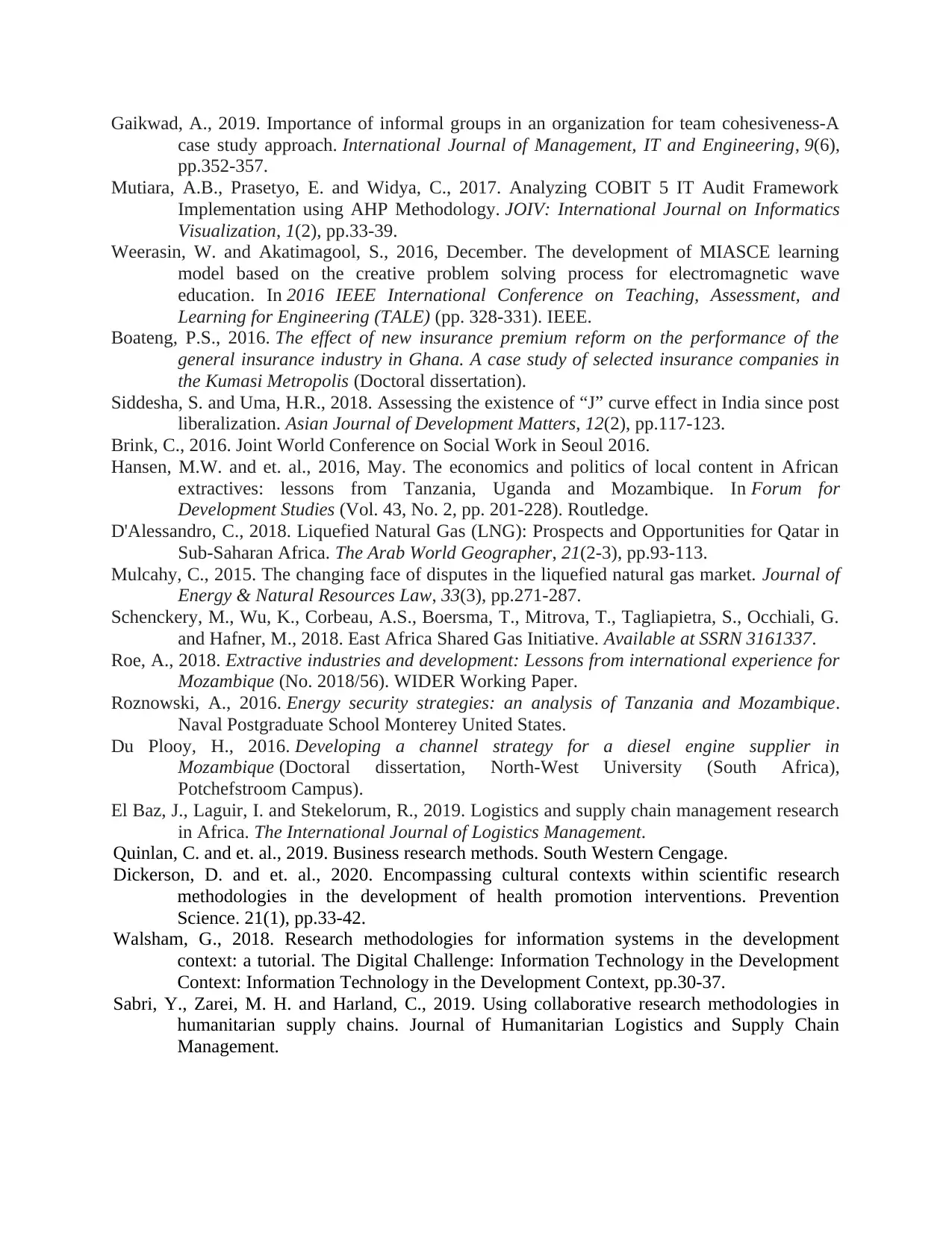
Gaikwad, A., 2019. Importance of informal groups in an organization for team cohesiveness-A
case study approach. International Journal of Management, IT and Engineering, 9(6),
pp.352-357.
Mutiara, A.B., Prasetyo, E. and Widya, C., 2017. Analyzing COBIT 5 IT Audit Framework
Implementation using AHP Methodology. JOIV: International Journal on Informatics
Visualization, 1(2), pp.33-39.
Weerasin, W. and Akatimagool, S., 2016, December. The development of MIASCE learning
model based on the creative problem solving process for electromagnetic wave
education. In 2016 IEEE International Conference on Teaching, Assessment, and
Learning for Engineering (TALE) (pp. 328-331). IEEE.
Boateng, P.S., 2016. The effect of new insurance premium reform on the performance of the
general insurance industry in Ghana. A case study of selected insurance companies in
the Kumasi Metropolis (Doctoral dissertation).
Siddesha, S. and Uma, H.R., 2018. Assessing the existence of “J” curve effect in India since post
liberalization. Asian Journal of Development Matters, 12(2), pp.117-123.
Brink, C., 2016. Joint World Conference on Social Work in Seoul 2016.
Hansen, M.W. and et. al., 2016, May. The economics and politics of local content in African
extractives: lessons from Tanzania, Uganda and Mozambique. In Forum for
Development Studies (Vol. 43, No. 2, pp. 201-228). Routledge.
D'Alessandro, C., 2018. Liquefied Natural Gas (LNG): Prospects and Opportunities for Qatar in
Sub-Saharan Africa. The Arab World Geographer, 21(2-3), pp.93-113.
Mulcahy, C., 2015. The changing face of disputes in the liquefied natural gas market. Journal of
Energy & Natural Resources Law, 33(3), pp.271-287.
Schenckery, M., Wu, K., Corbeau, A.S., Boersma, T., Mitrova, T., Tagliapietra, S., Occhiali, G.
and Hafner, M., 2018. East Africa Shared Gas Initiative. Available at SSRN 3161337.
Roe, A., 2018. Extractive industries and development: Lessons from international experience for
Mozambique (No. 2018/56). WIDER Working Paper.
Roznowski, A., 2016. Energy security strategies: an analysis of Tanzania and Mozambique.
Naval Postgraduate School Monterey United States.
Du Plooy, H., 2016. Developing a channel strategy for a diesel engine supplier in
Mozambique (Doctoral dissertation, North-West University (South Africa),
Potchefstroom Campus).
El Baz, J., Laguir, I. and Stekelorum, R., 2019. Logistics and supply chain management research
in Africa. The International Journal of Logistics Management.
Quinlan, C. and et. al., 2019. Business research methods. South Western Cengage.
Dickerson, D. and et. al., 2020. Encompassing cultural contexts within scientific research
methodologies in the development of health promotion interventions. Prevention
Science. 21(1), pp.33-42.
Walsham, G., 2018. Research methodologies for information systems in the development
context: a tutorial. The Digital Challenge: Information Technology in the Development
Context: Information Technology in the Development Context, pp.30-37.
Sabri, Y., Zarei, M. H. and Harland, C., 2019. Using collaborative research methodologies in
humanitarian supply chains. Journal of Humanitarian Logistics and Supply Chain
Management.
case study approach. International Journal of Management, IT and Engineering, 9(6),
pp.352-357.
Mutiara, A.B., Prasetyo, E. and Widya, C., 2017. Analyzing COBIT 5 IT Audit Framework
Implementation using AHP Methodology. JOIV: International Journal on Informatics
Visualization, 1(2), pp.33-39.
Weerasin, W. and Akatimagool, S., 2016, December. The development of MIASCE learning
model based on the creative problem solving process for electromagnetic wave
education. In 2016 IEEE International Conference on Teaching, Assessment, and
Learning for Engineering (TALE) (pp. 328-331). IEEE.
Boateng, P.S., 2016. The effect of new insurance premium reform on the performance of the
general insurance industry in Ghana. A case study of selected insurance companies in
the Kumasi Metropolis (Doctoral dissertation).
Siddesha, S. and Uma, H.R., 2018. Assessing the existence of “J” curve effect in India since post
liberalization. Asian Journal of Development Matters, 12(2), pp.117-123.
Brink, C., 2016. Joint World Conference on Social Work in Seoul 2016.
Hansen, M.W. and et. al., 2016, May. The economics and politics of local content in African
extractives: lessons from Tanzania, Uganda and Mozambique. In Forum for
Development Studies (Vol. 43, No. 2, pp. 201-228). Routledge.
D'Alessandro, C., 2018. Liquefied Natural Gas (LNG): Prospects and Opportunities for Qatar in
Sub-Saharan Africa. The Arab World Geographer, 21(2-3), pp.93-113.
Mulcahy, C., 2015. The changing face of disputes in the liquefied natural gas market. Journal of
Energy & Natural Resources Law, 33(3), pp.271-287.
Schenckery, M., Wu, K., Corbeau, A.S., Boersma, T., Mitrova, T., Tagliapietra, S., Occhiali, G.
and Hafner, M., 2018. East Africa Shared Gas Initiative. Available at SSRN 3161337.
Roe, A., 2018. Extractive industries and development: Lessons from international experience for
Mozambique (No. 2018/56). WIDER Working Paper.
Roznowski, A., 2016. Energy security strategies: an analysis of Tanzania and Mozambique.
Naval Postgraduate School Monterey United States.
Du Plooy, H., 2016. Developing a channel strategy for a diesel engine supplier in
Mozambique (Doctoral dissertation, North-West University (South Africa),
Potchefstroom Campus).
El Baz, J., Laguir, I. and Stekelorum, R., 2019. Logistics and supply chain management research
in Africa. The International Journal of Logistics Management.
Quinlan, C. and et. al., 2019. Business research methods. South Western Cengage.
Dickerson, D. and et. al., 2020. Encompassing cultural contexts within scientific research
methodologies in the development of health promotion interventions. Prevention
Science. 21(1), pp.33-42.
Walsham, G., 2018. Research methodologies for information systems in the development
context: a tutorial. The Digital Challenge: Information Technology in the Development
Context: Information Technology in the Development Context, pp.30-37.
Sabri, Y., Zarei, M. H. and Harland, C., 2019. Using collaborative research methodologies in
humanitarian supply chains. Journal of Humanitarian Logistics and Supply Chain
Management.

Bendell, R., Vasquez, G. and Jentsch, F., 2019. Human performance with autonomous robotic
teammates: research methodologies and simulations. In Human Performance in
Automated and Autonomous Systems (pp. 175-198). CRC Press.
Özerdem, A. and Bowd, R., 2016. Participatory research methodologies: Development and post-
disaster/conflict reconstruction. Routledge.
Anae, M., 2019. Pacific Research Methodologies and Relational Ethics. In Oxford Research
Encyclopedia of Education.
Fleisher, M., 2017. Prison gangs, street gangs: A critique of theories of prison violence and
prison research methodologies: Very rough draft. Street Gangs: A Critique of Theories
of Prison Violence and Prison Research Methodologies: Very Rough Draft (October 27,
2017).
Benson, P., 2019. Ways of seeing: The individual and the social in applied linguistics research
methodologies. Language Teaching, 52(1), pp.60-70.
Online
A Cleaner Source of Energy for the World, 2019. [Online]. Available through:
<http://www.mzlng.com/The-Project/>
Creating Opportunities for Mozambican Business and Local Workforce, 2020. [Online].
Available through: <https://www.ep.total.com/en/mozambique-lng-major-gas-project-
future-lng-africa>
teammates: research methodologies and simulations. In Human Performance in
Automated and Autonomous Systems (pp. 175-198). CRC Press.
Özerdem, A. and Bowd, R., 2016. Participatory research methodologies: Development and post-
disaster/conflict reconstruction. Routledge.
Anae, M., 2019. Pacific Research Methodologies and Relational Ethics. In Oxford Research
Encyclopedia of Education.
Fleisher, M., 2017. Prison gangs, street gangs: A critique of theories of prison violence and
prison research methodologies: Very rough draft. Street Gangs: A Critique of Theories
of Prison Violence and Prison Research Methodologies: Very Rough Draft (October 27,
2017).
Benson, P., 2019. Ways of seeing: The individual and the social in applied linguistics research
methodologies. Language Teaching, 52(1), pp.60-70.
Online
A Cleaner Source of Energy for the World, 2019. [Online]. Available through:
<http://www.mzlng.com/The-Project/>
Creating Opportunities for Mozambican Business and Local Workforce, 2020. [Online].
Available through: <https://www.ep.total.com/en/mozambique-lng-major-gas-project-
future-lng-africa>
1 out of 21
Related Documents
Your All-in-One AI-Powered Toolkit for Academic Success.
+13062052269
info@desklib.com
Available 24*7 on WhatsApp / Email
![[object Object]](/_next/static/media/star-bottom.7253800d.svg)
Unlock your academic potential
© 2024 | Zucol Services PVT LTD | All rights reserved.





